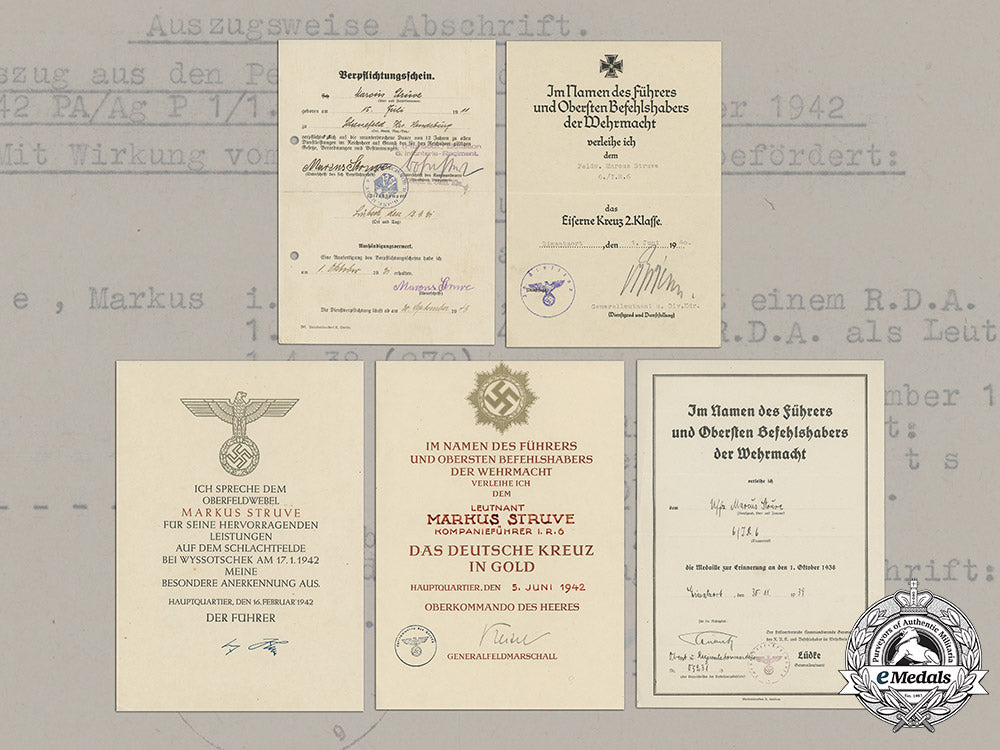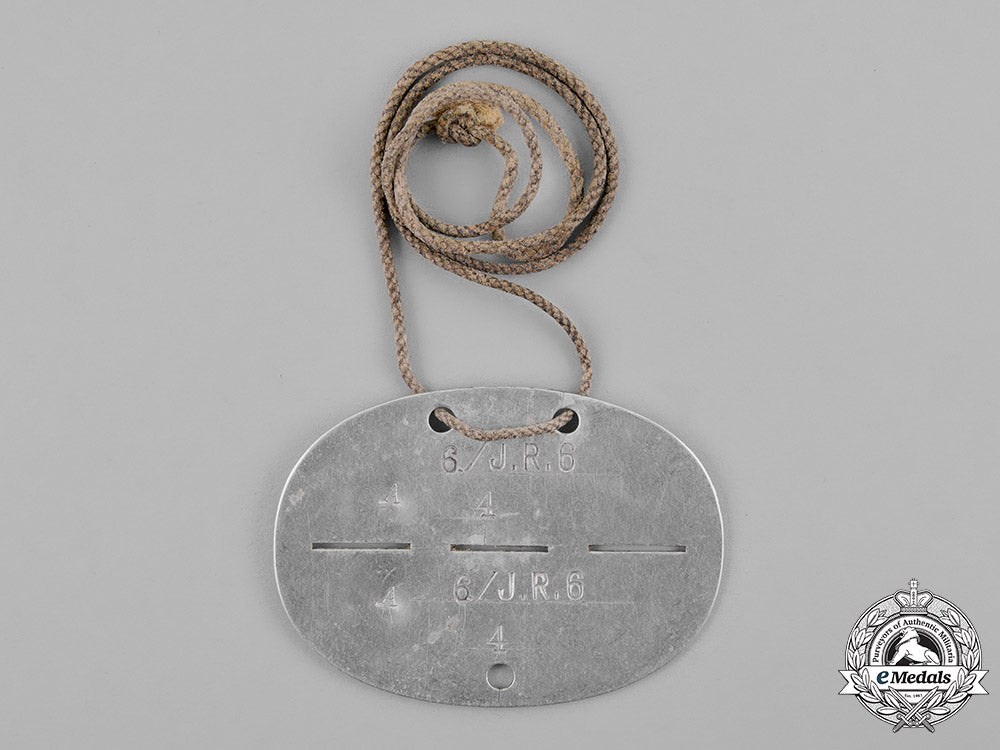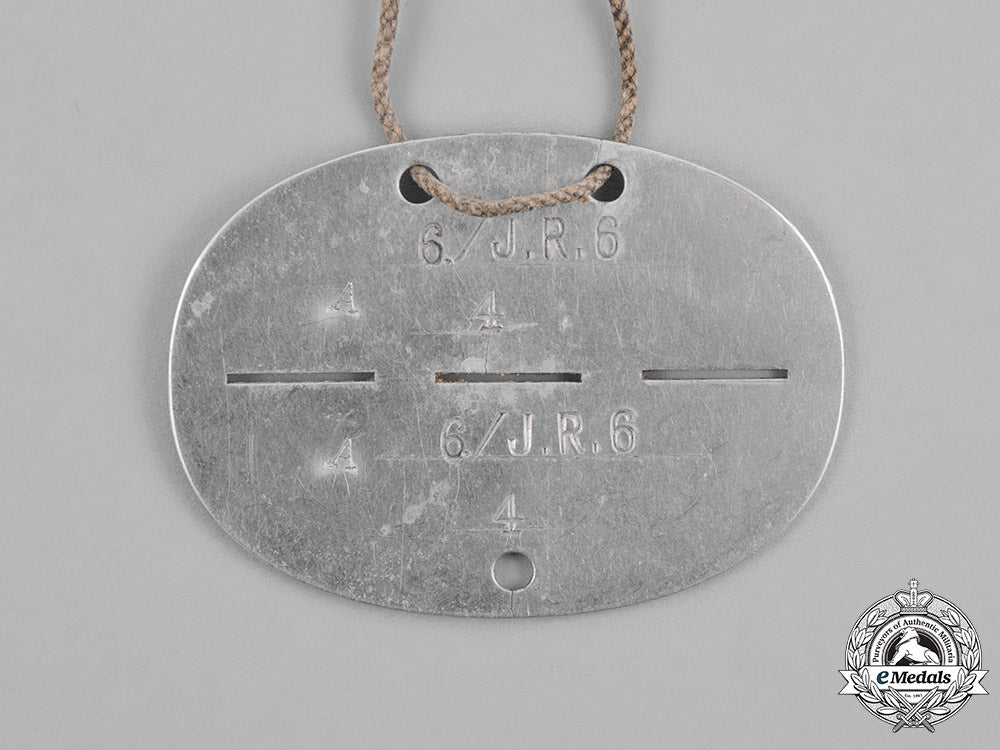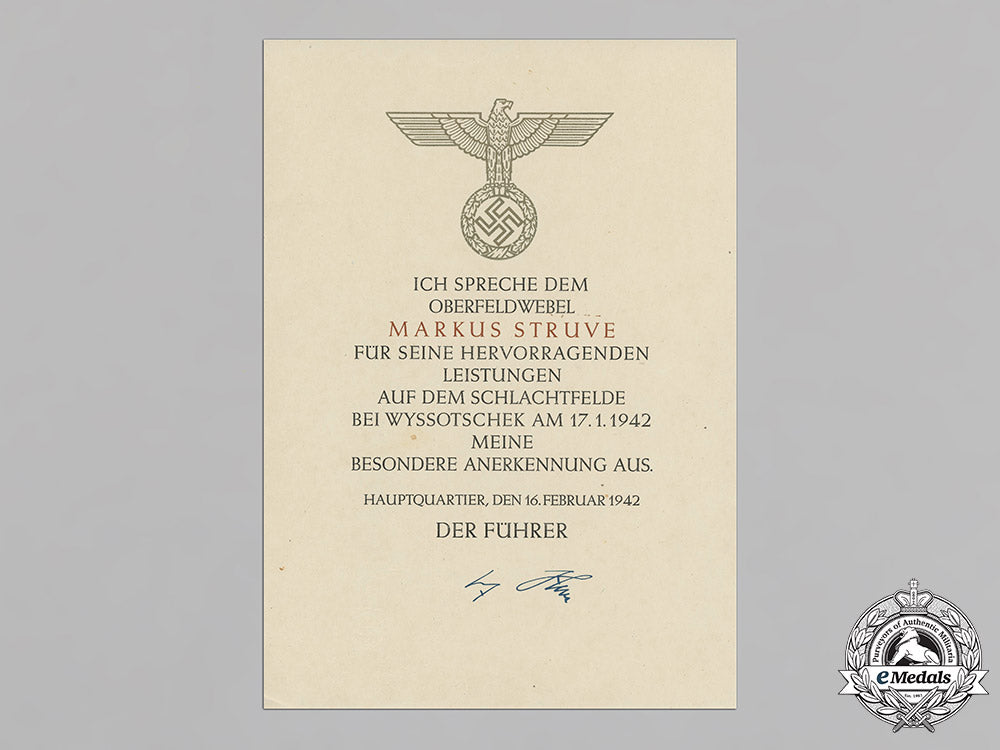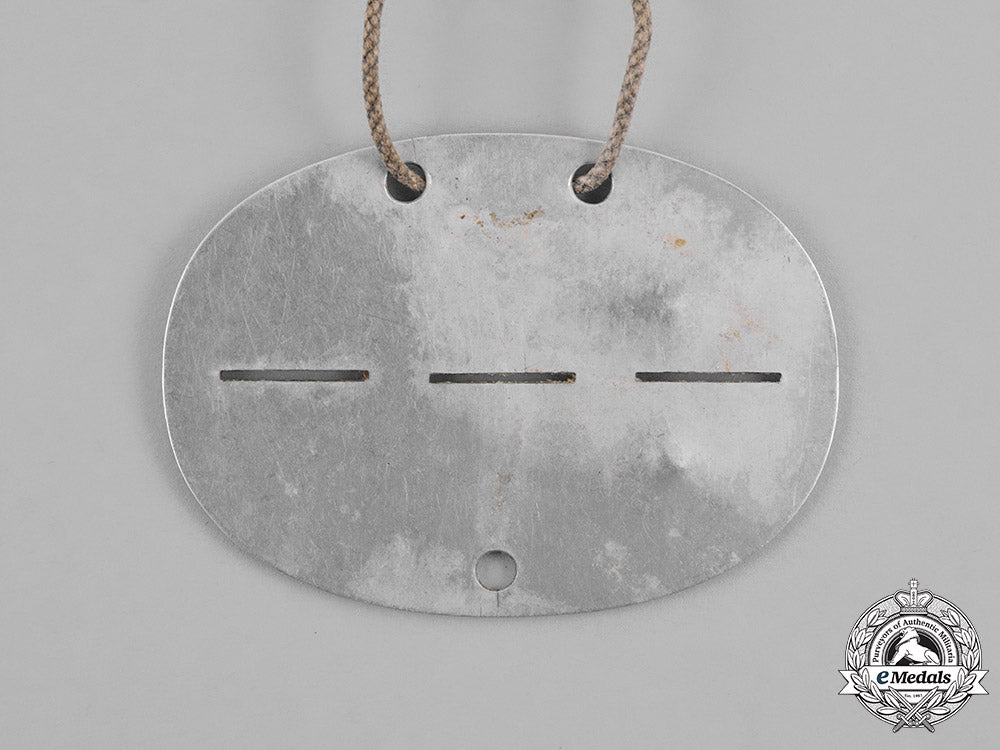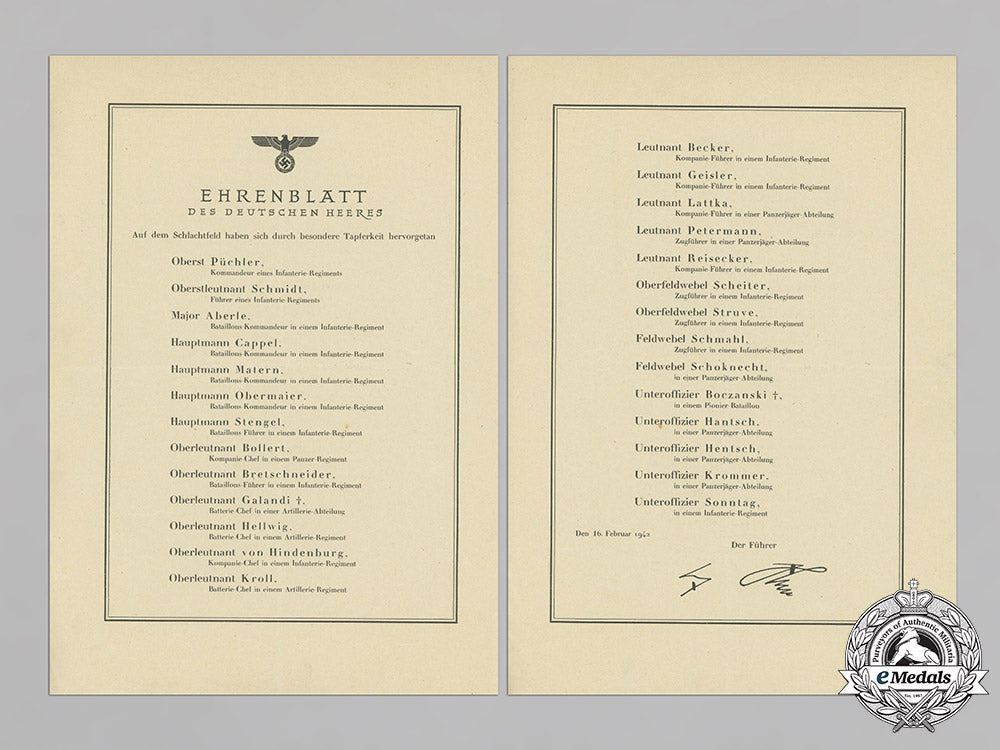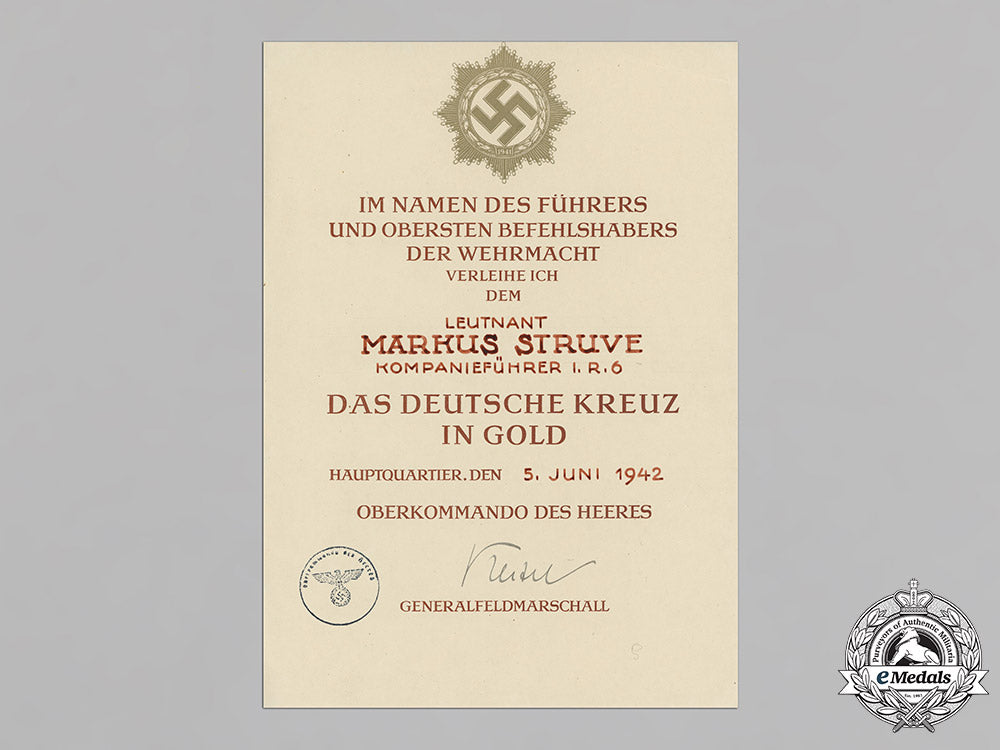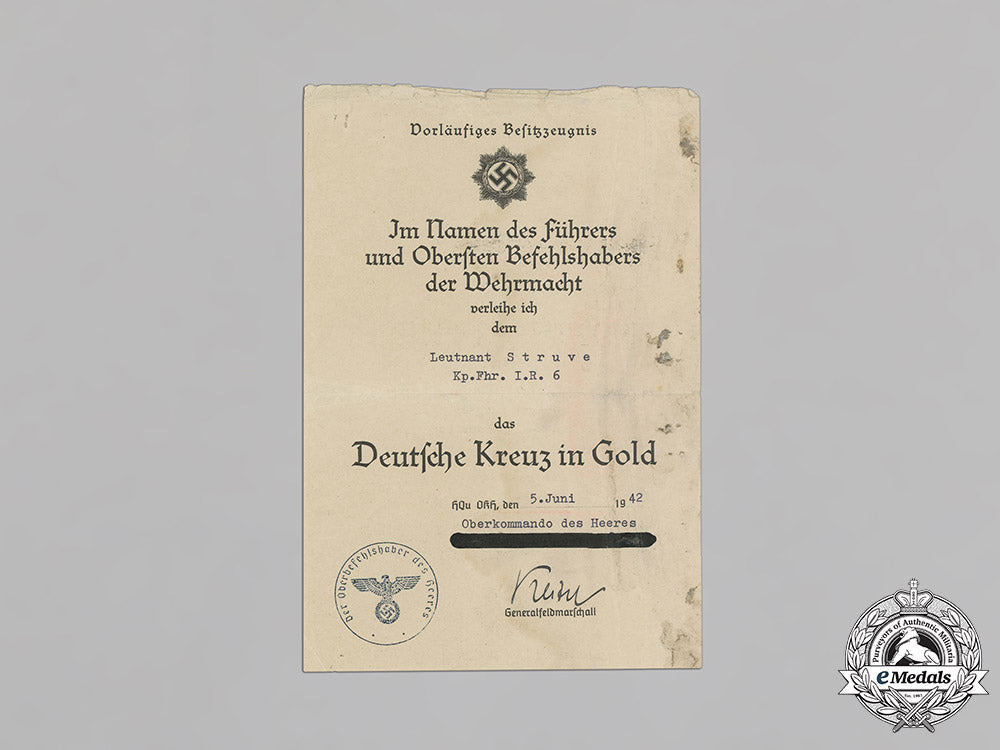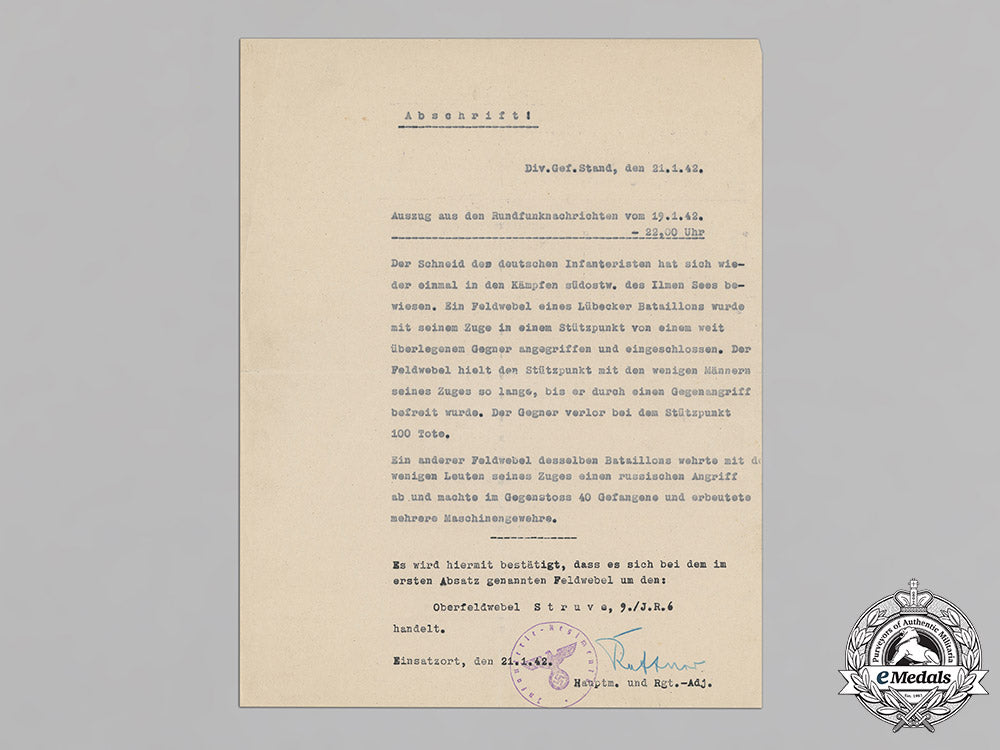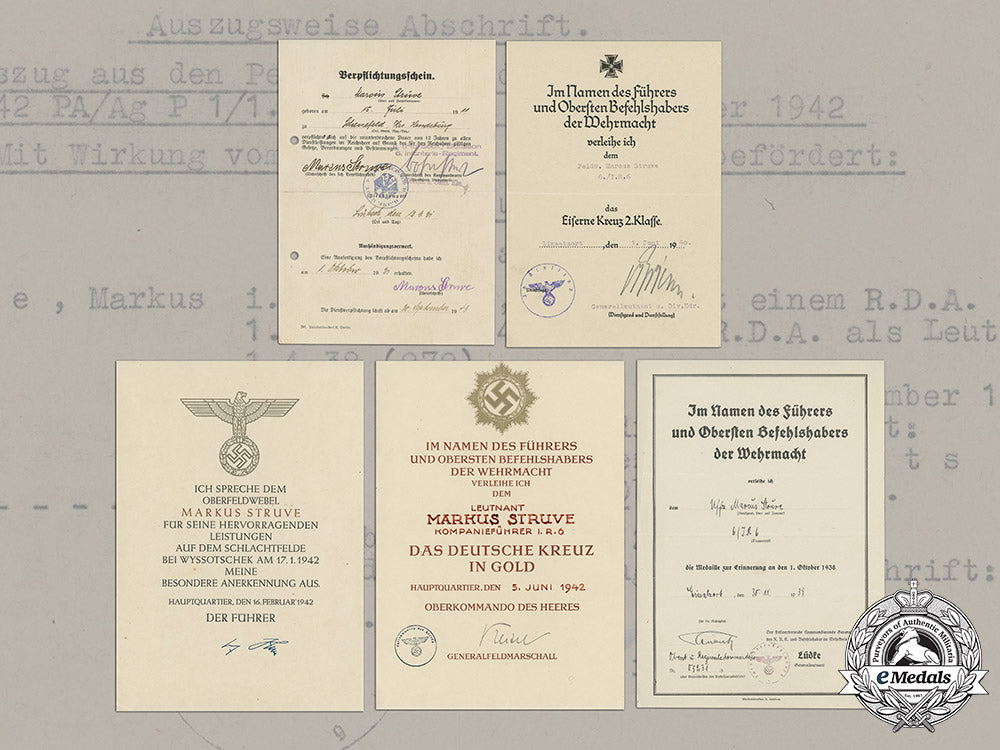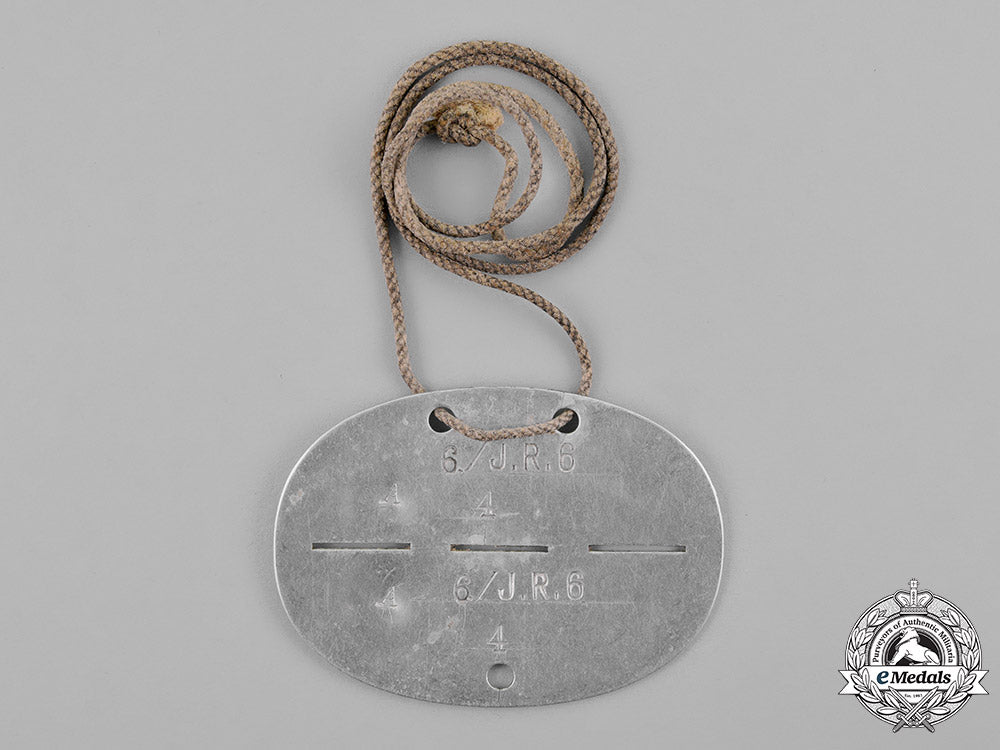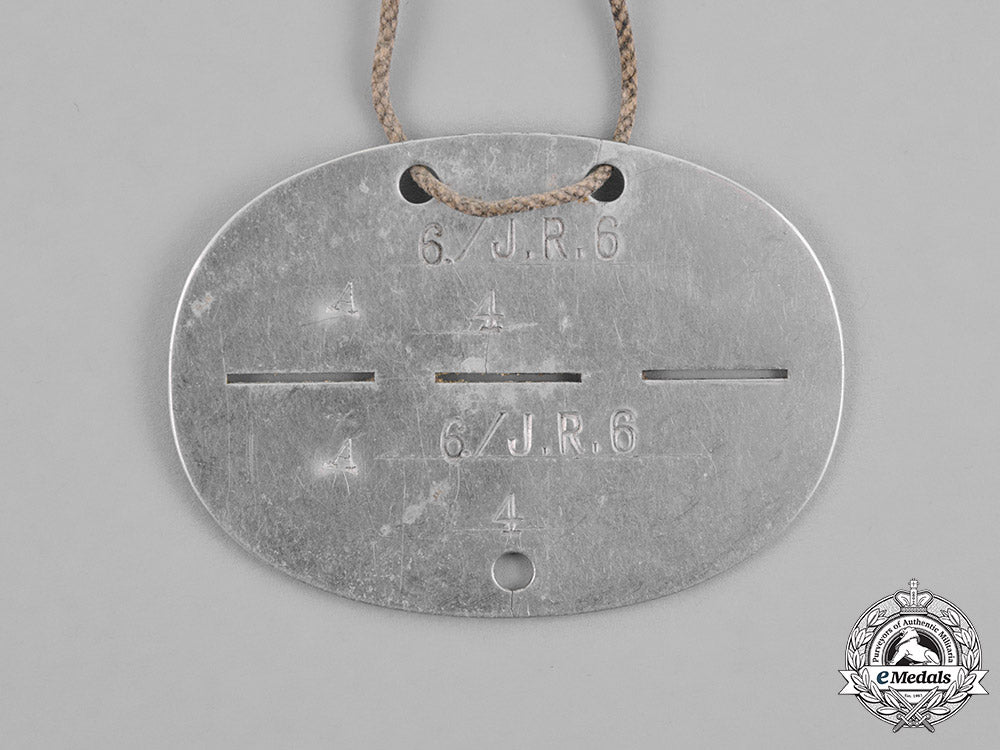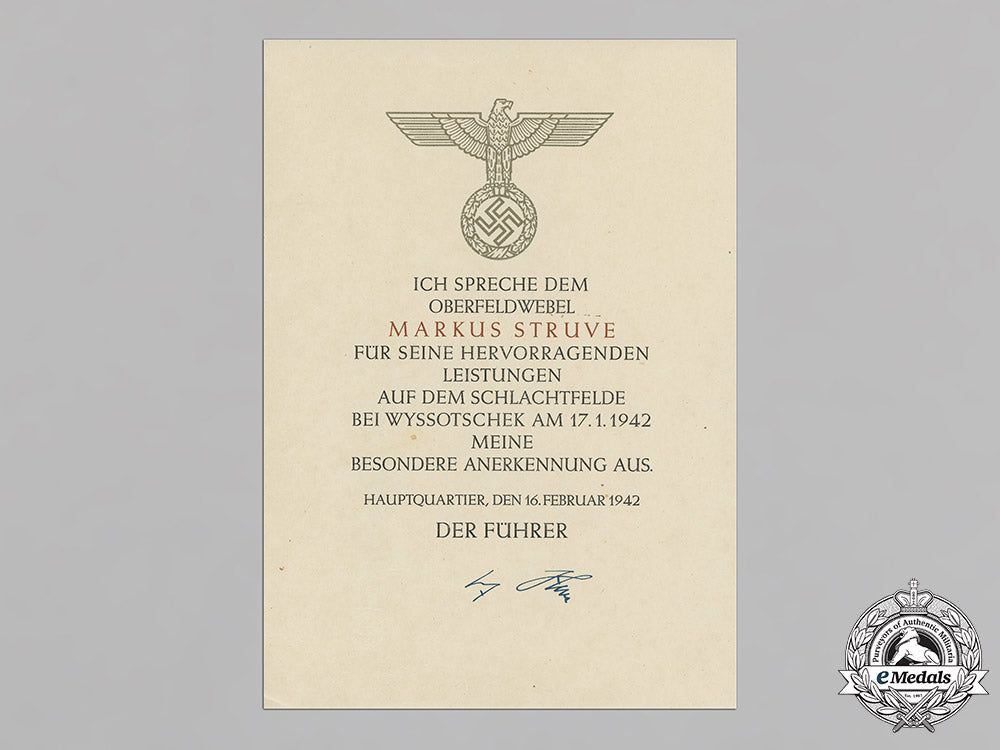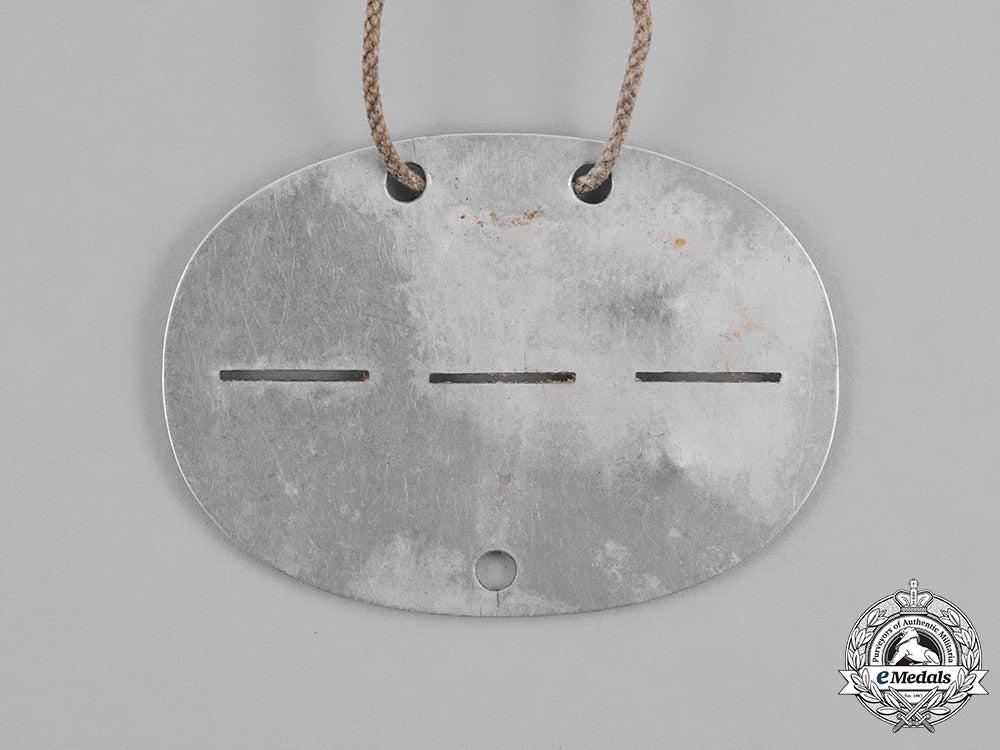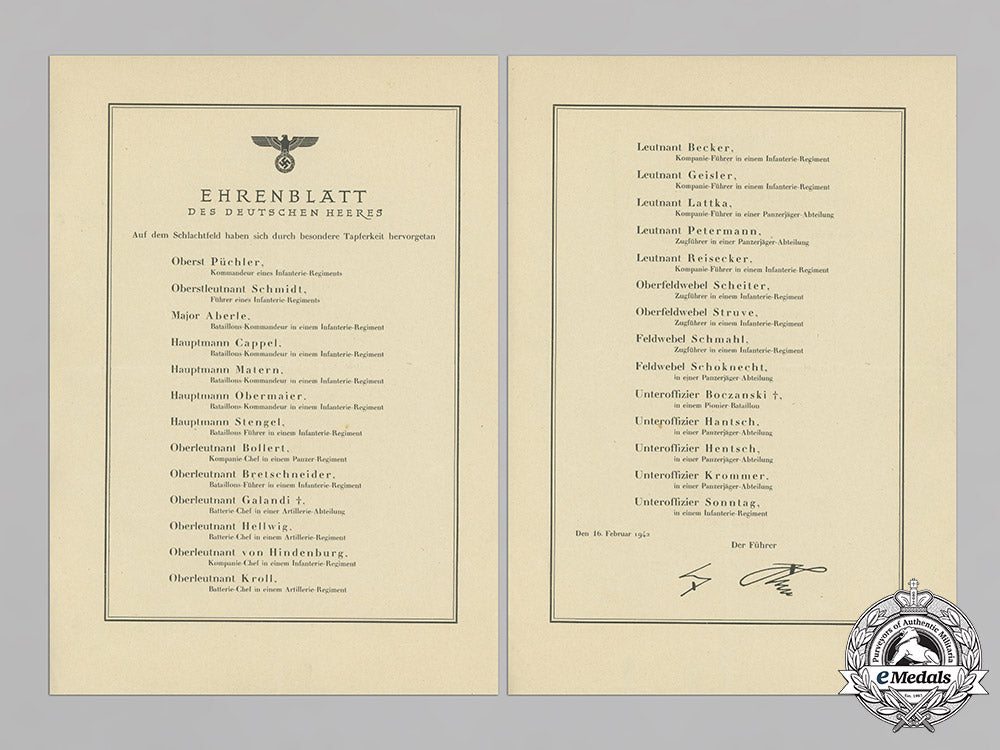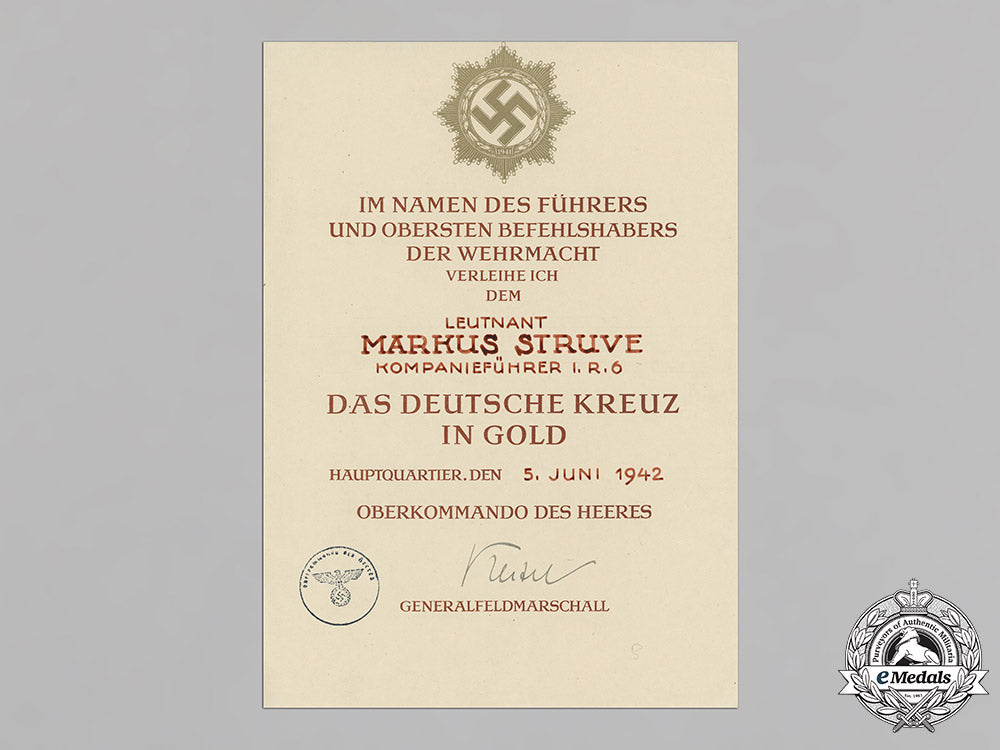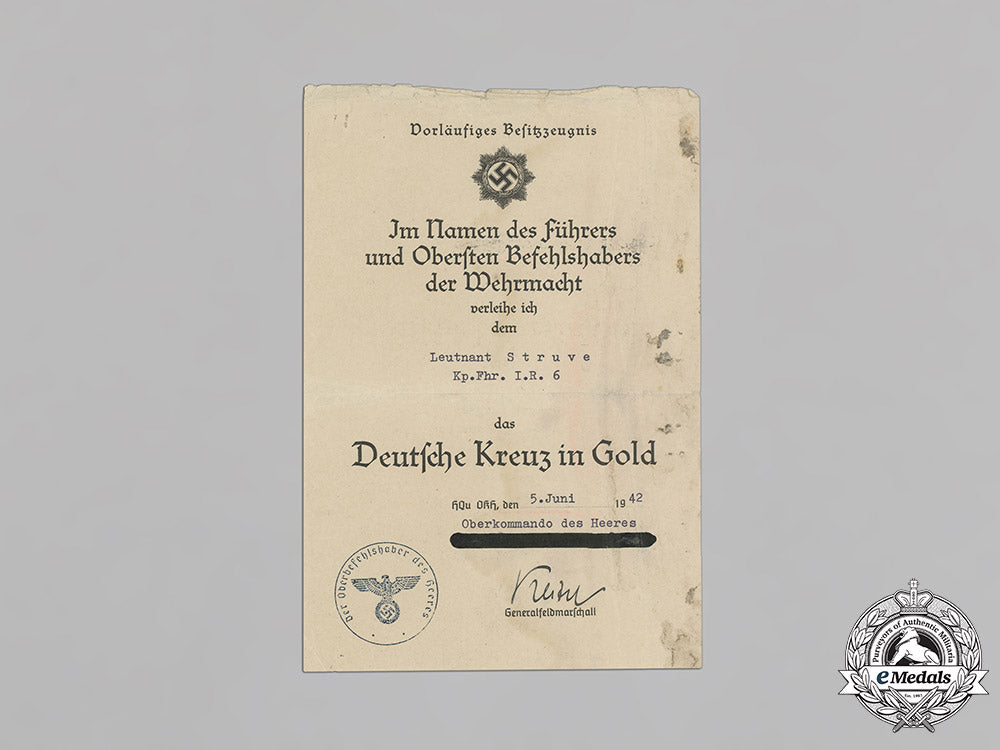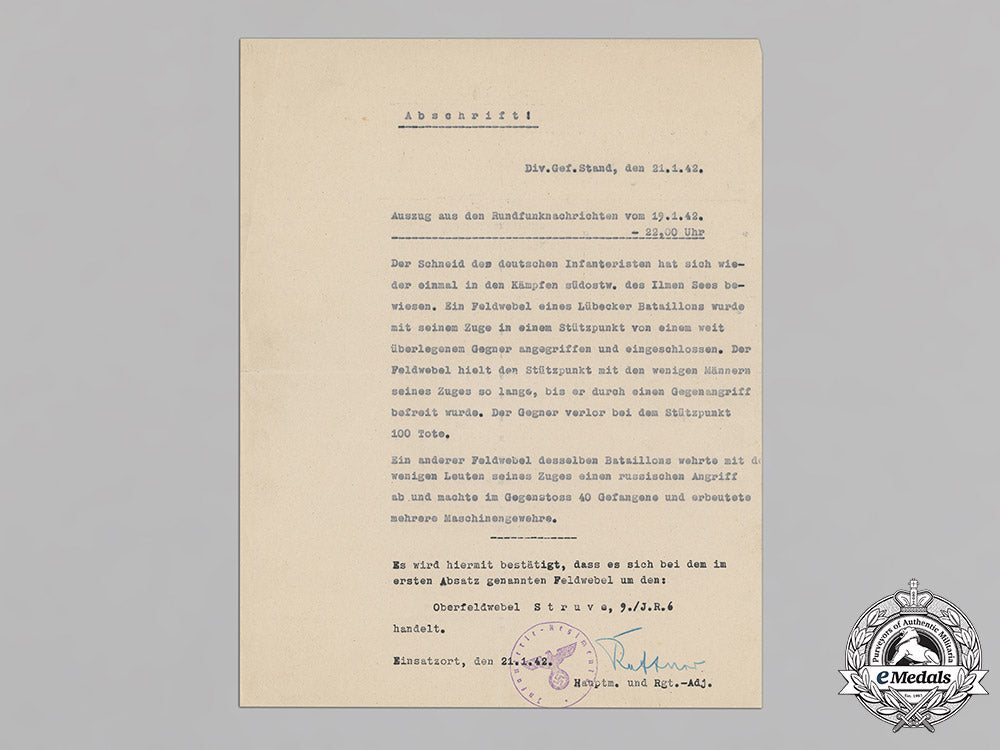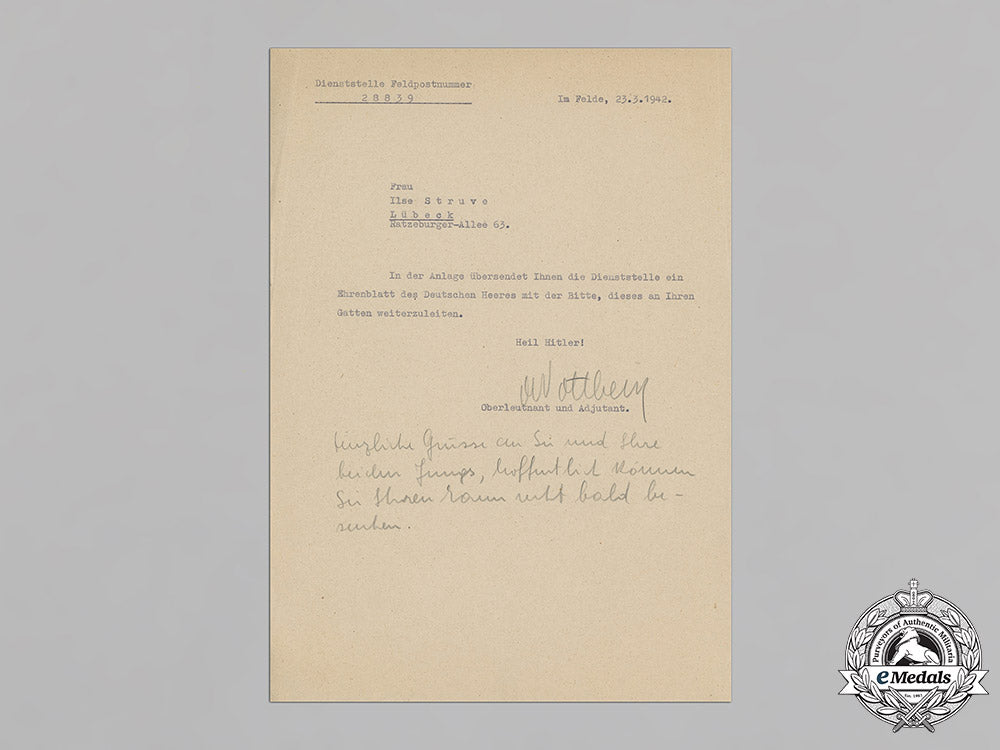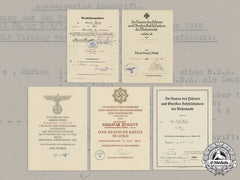
LOADING ...
In response to evolving domestic opinion, eMedals Inc has made the conscious decision to remove the presentation of German Third Reich historical artifacts from our online catalogue. For three decades, eMedals Inc has made an effort to preserve history in all its forms. As historians and researchers, we have managed sensitive articles and materials with the greatest of care and respect for their past and present social context. We acknowledge the growing sentiments put forth by the Canadian public and have taken proactive actions to address this opinion.
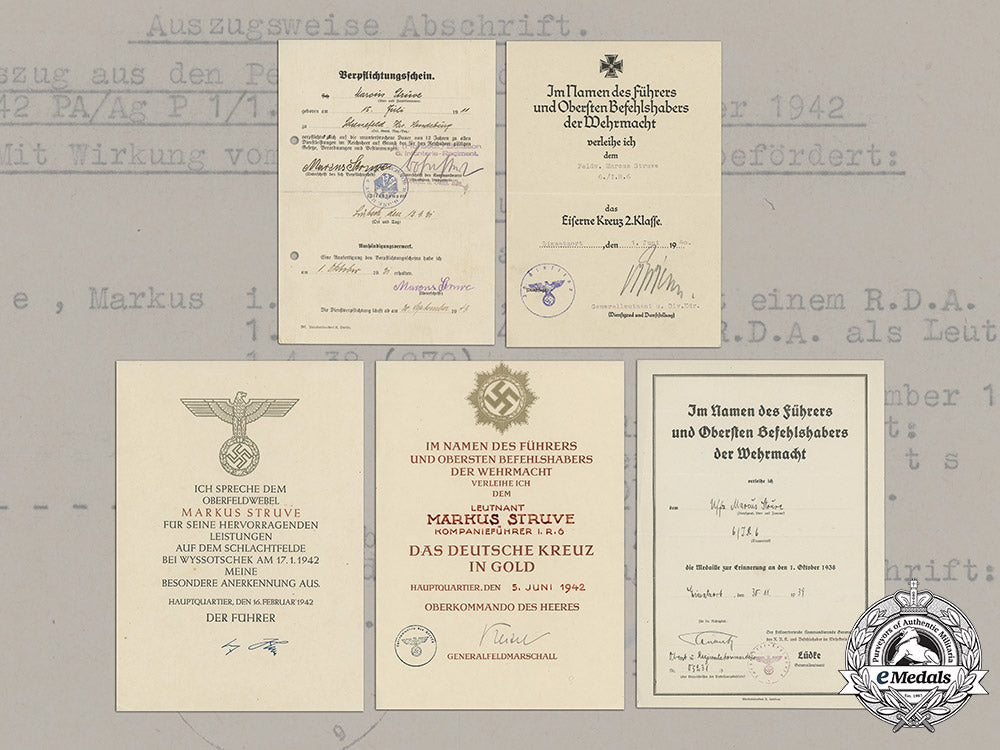
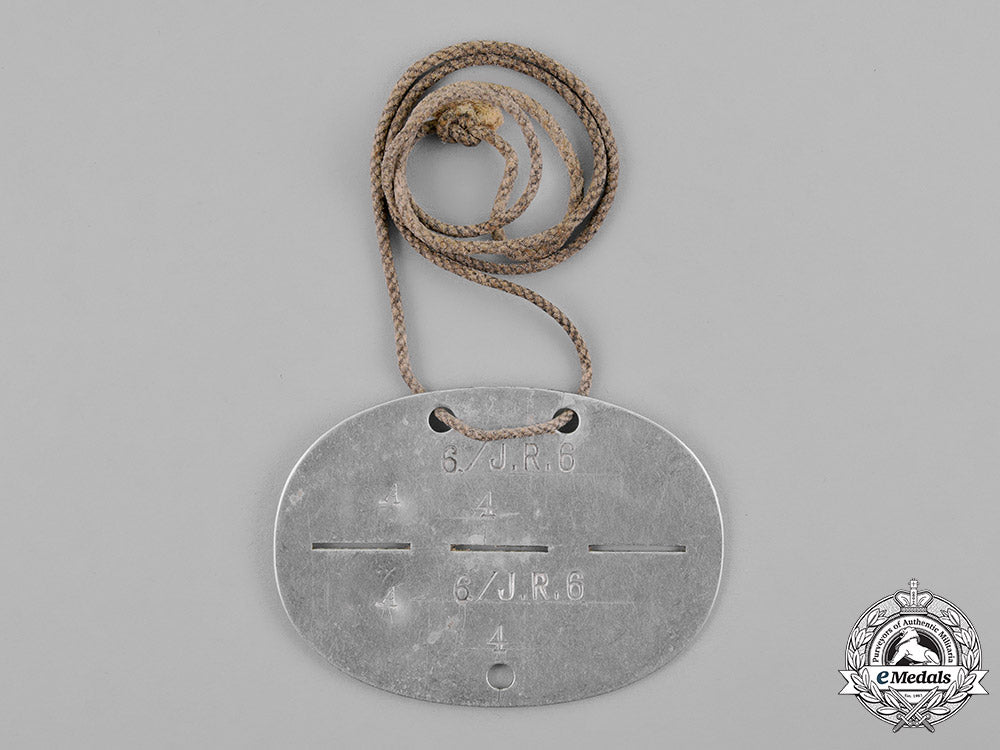
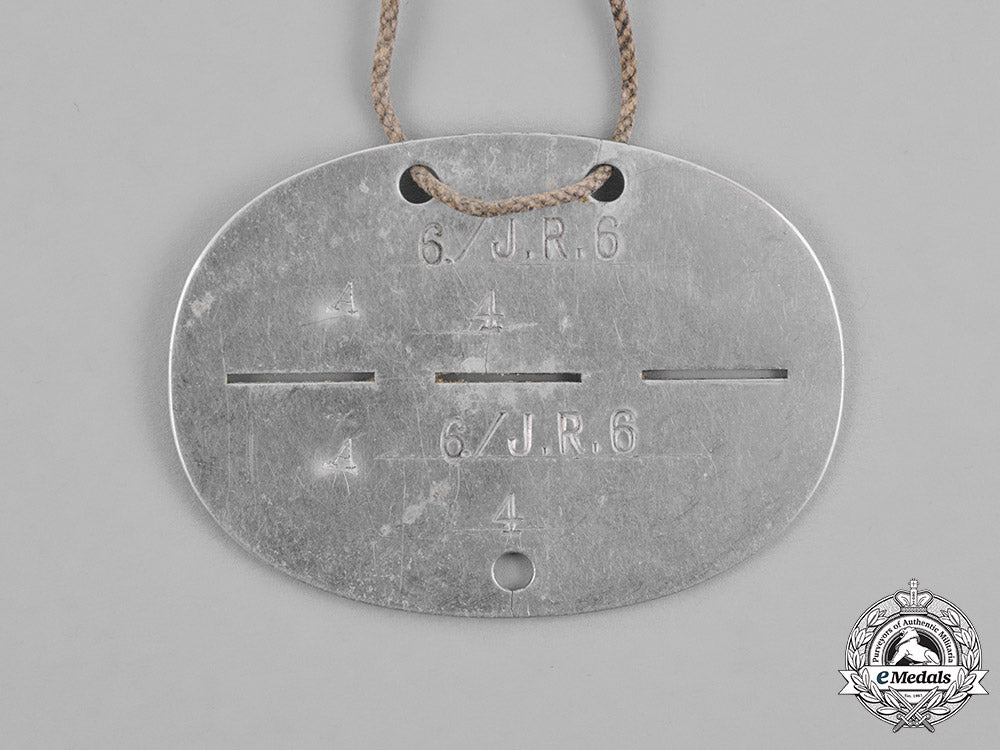
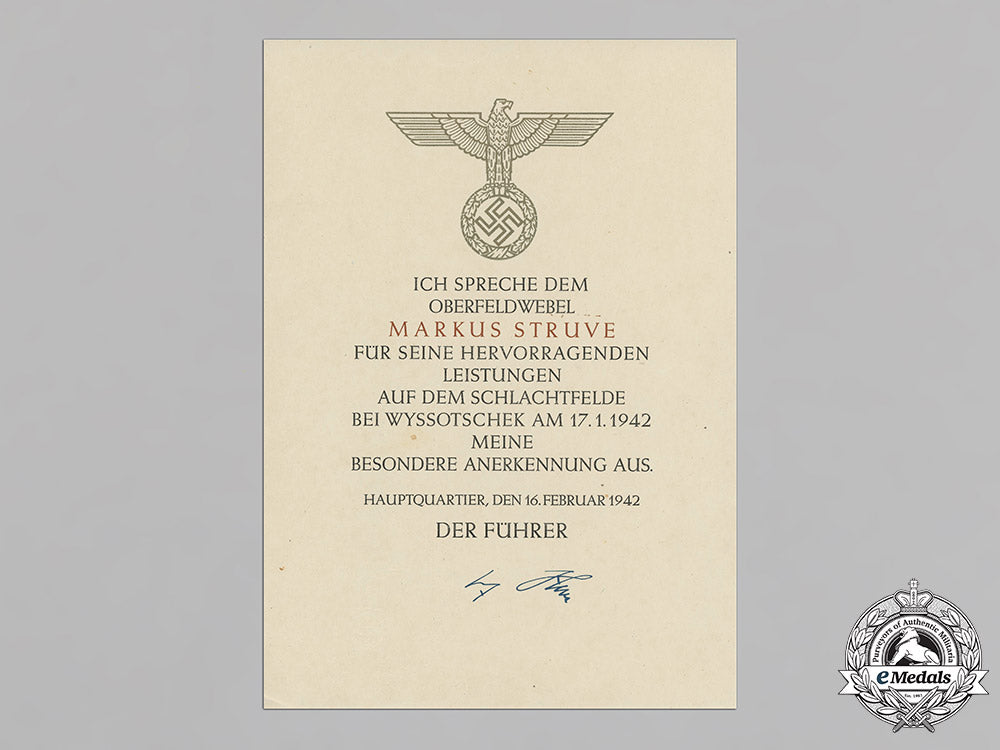
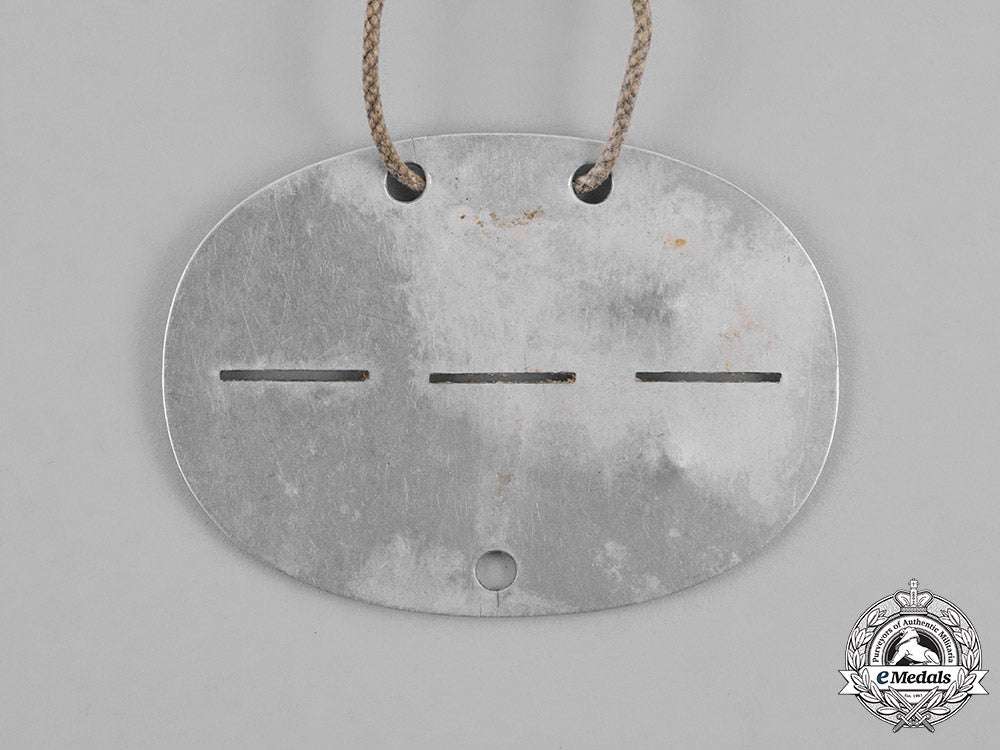
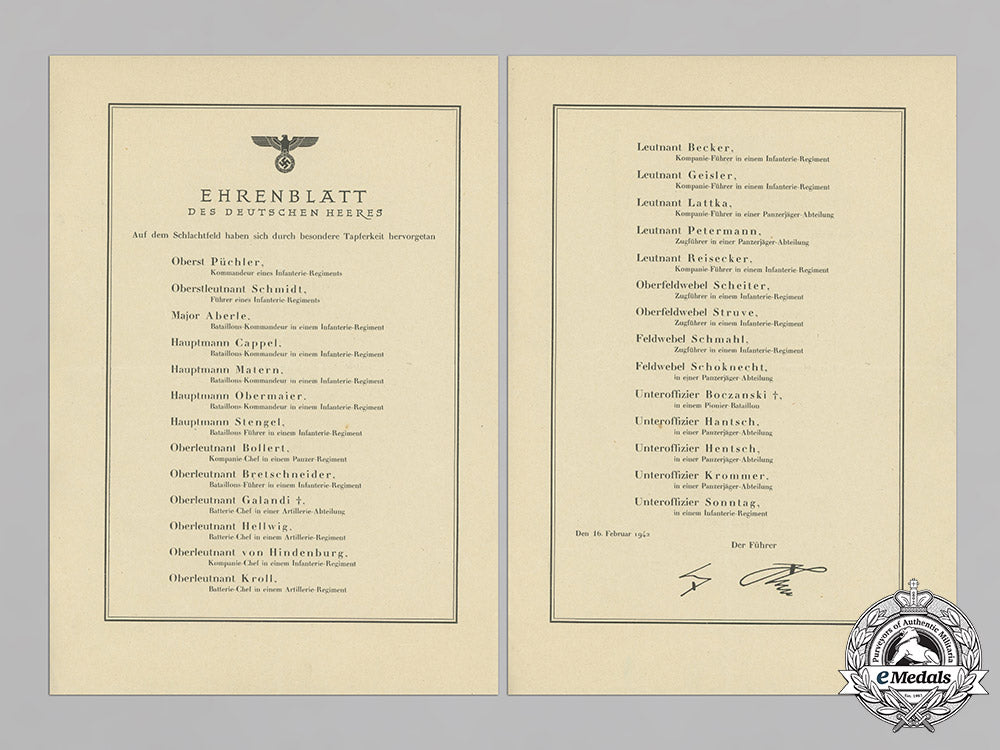
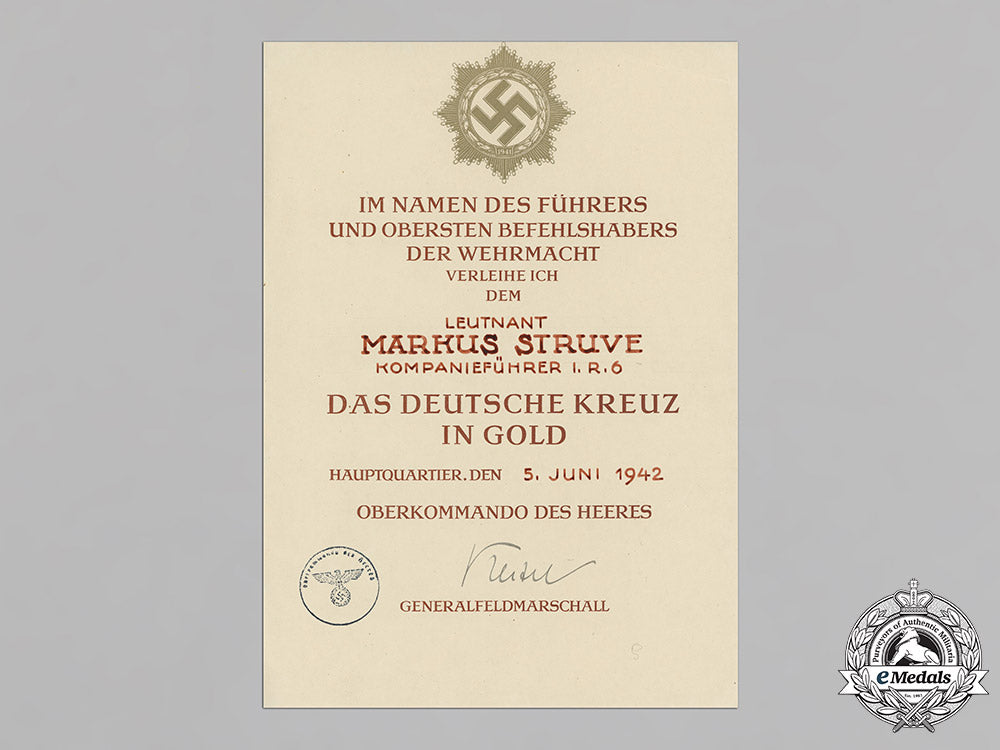
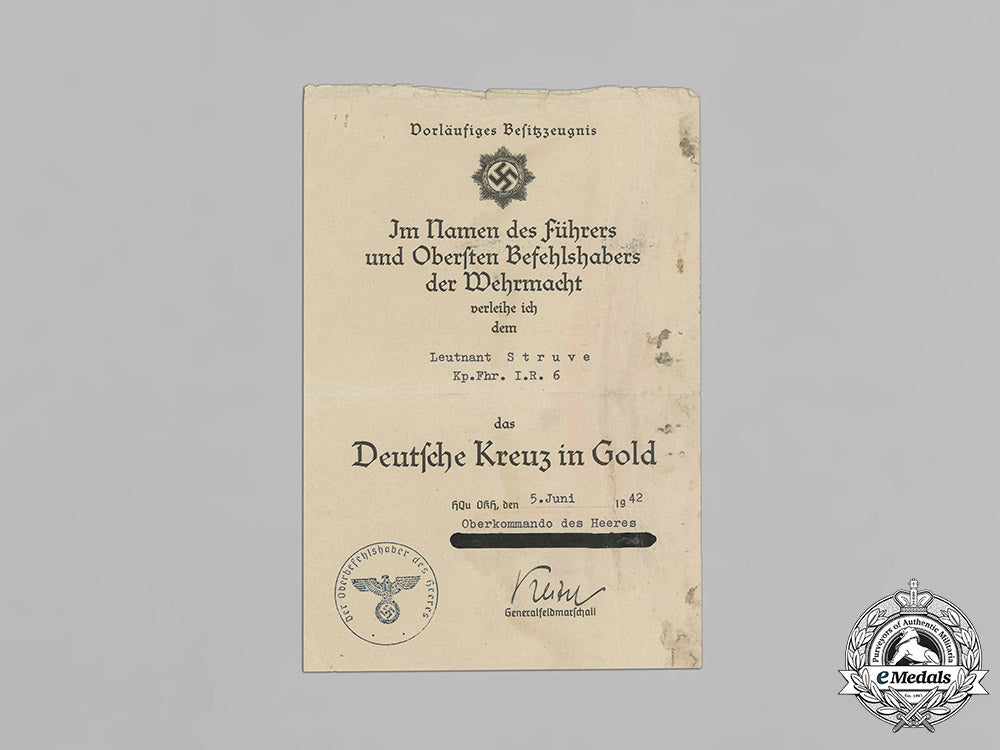
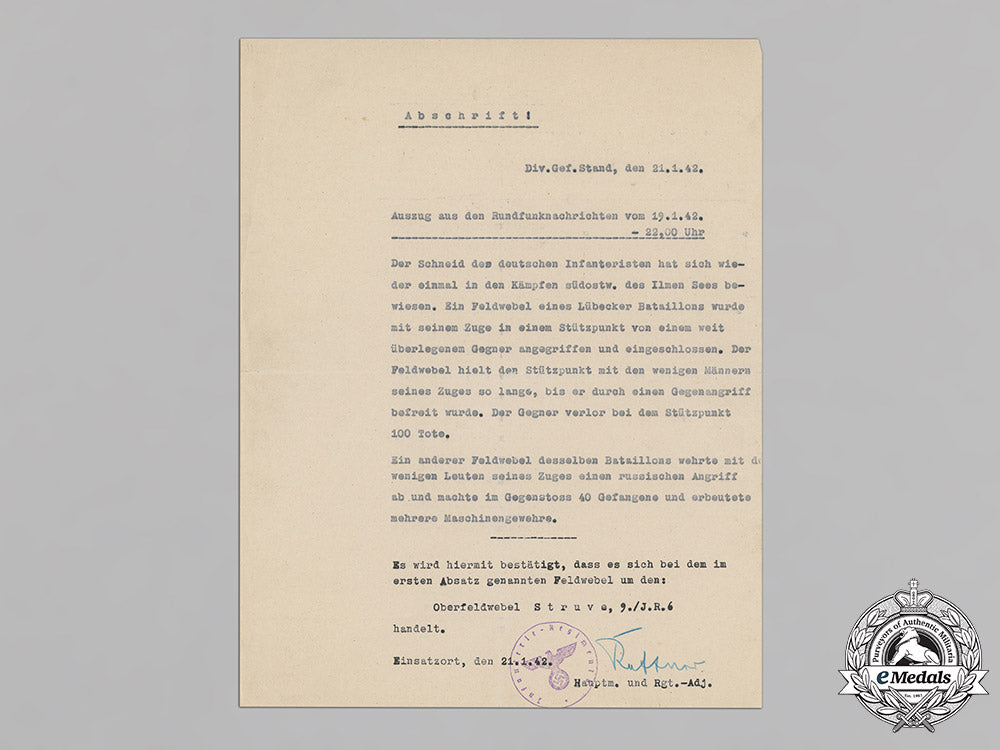
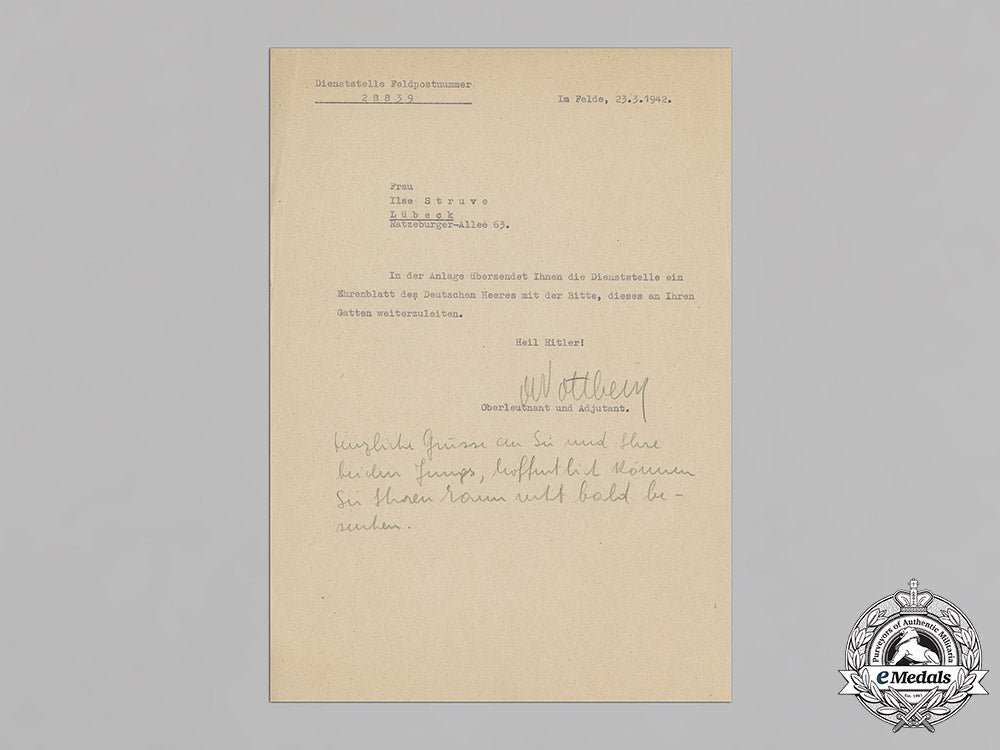
Germany, Heer. An Extensive Document Collection To Hauptmann Markus Struve (Honour Roll Clasp, Dkig)
Germany, Heer. An Extensive Document Collection To Hauptmann Markus Struve (Honour Roll Clasp, Dkig)
SKU: ITEM: G36972
Current Bid:
Your Max Bid:
Bid History:
Time Remaining:
Couldn't load pickup availability
Shipping Details
Shipping Details
eMedals offers rapid domestic and international shipping. Orders received prior to 12:00pm (EST) will be shipped on the same business day.* Orders placed on Canadian Federal holidays will be dispatched the subsequent business day. Courier tracking numbers are provided for all shipments. All items purchased from eMedals can be returned for a full monetary refund or merchandise credit, providing the criteria presented in our Terms & Conditions are met. *Please note that the addition of a COA may impact dispatch time.
Shipping Details
eMedals offers rapid domestic and international shipping. Orders received prior to 12:00pm (EST) will be shipped on the same business day.* Orders placed on Canadian Federal holidays will be dispatched the subsequent business day. Courier tracking numbers are provided for all shipments. All items purchased from eMedals can be returned for a full monetary refund or merchandise credit, providing the criteria presented in our Terms & Conditions are met. *Please note that the addition of a COA may impact dispatch time.
Description
Description
The collection consists of: an Honour Roll Clasp award document (210x296mm, very fine) with official Honour Roll listing document (418x297mm, near very fine) and accompanying letter (210x297mm, near very fine); an official confirmation of circumstances leading to Honour Roll Clasp award (210x270mm, better than fine) with retelling in local newspaper (317x469mm, fine); a German Cross in Gold award document (212x297mm, better than very fine; has been cut to fit plastic sleeve); a preliminary German Cross in Gold award document (136x200mm, fine); an Iron Cross 1st Class award document (140x199mm, near very fine); an Iron Cross 2nd Class award document (140x200mm, very fine); a War Merit Cross 2nd Class with Swords award document (148x210mm, better than very fine); two Demyansk Shield award documents (148x210mm, better than very fine); an Infantry Assault Badge award document (209x148mm, very fine); three letters concerning promotion to Hauptmann (208x148mm, poor to near very fine); five letters concerning promotion to Oberleutnant (212x148mm, fair to better than fine); a letter of transfer to active officer status (209x297mm, near very fine); a promotion document to Feldwebel (208x293mm, better than very fine); a Wehrmacht Long Service 4 Years award document (210x297mm, very fine); a Sudetenland Medal award document (210x295mm, near very fine); an indefinite Wehrmacht service commitment document (209x296mm, near very fine); a 12 year Wehrmacht service commitment document (153x214mm, near very fine); a letter certifying length of military service (209x148mm, near very fine); a newspaper report about the 10th Company of Grenadier Regiment 6 (8 p., 267x360mm, fine); a dog tag (aluminum, 70x50mm, fine); 20 army pay stubs (148x105mm, fine to very fine).
The Honour Roll Clasp award document is named to Oberfeldwebel (Master Sergeant) Struve, “for his outstanding achievements on the battlefield” near Wyssotschek on January 17, 1942. It is dated to February 16, 1942 and carries a facsimile of A.H. The official Honour Roll listing document features Struve’s name among 26 other recipients. He is listed as a Zugführer (Platoon Leader) in an Infantry Regiment. The document is dated to February 16, 1942 and carries a facsimile of A.H.
The accompanying letter is addressed to Struve’s wife Ilse in Lübeck (northern Germany). The sender is the Staff of Grenadier Regiment 6 (Feldpost number 28839). The letter is dated to March 23, 1942 and asks Mrs. Struve to give the accompanying Honour Roll Clasp to her husband. The document is signed in pencil by an Oberleutnant and Adjutant, the name is illegible. A handwritten note at the bottom says: “Greetings to you and your two boys, hopefully you can visit your husband soon.”
The document concerning the circumstances of the Honour Roll award is a transcript of a radio news story from January 19, 1942. It describes events southeast of Lake Ilmen. A Feldwebel of a Lübeck battalion and his platoon were attacked and encircled by superior enemy forces. The Feldwebel and his small group of men held the base until a German counter-attack relieved them. The enemy lost 100 men during the failed attack. Below the transcript is a statement saying that the Feldwebel from the news report is indeed Oberfeldwebel Struve of the 9th Infantry Regiment 6. The document is dated to January 21, 1942 and signed by a Hauptmann and Regiment Adjutant, the name could be Ruttner.
The front page of the newspaper “Lübecker General-Anzeiger”, issue from January 20, 1942, retells the same story.
The German Cross in Gold award document is named to Leutnant Struve, a Company Leader in Infantry Regiment 6. It is dated to June 5, 1942 and signed in blue ink by General Field Marshal Wilhelm Keitel (1882–1946), Chief of the Supreme Command of the Armed Forces and a recipient of the Knight’s Cross.
The preliminary German Cross in Gold award document is named to Leutnant Struve. It is dated to June 5, 1942 and once more signed by Keitel.
The Iron Cross 1st Class document is named to Feldwebel Struve of the 6th Company of Infantry Regiment 6. It is dated to July 14, 1940 and signed in pencil by the Commander of the 30th Infantry Division, General der Infanterie Kurt von Briesen (1883–1941), a recipient of the Knight’s Cross.
The Iron Cross 2nd Class document is named to Feldwebel Struve of the 6th Company of Infantry Regiment 6. It is dated to June 1, 1940 and once more signed in pencil by von Briesen.
The War Merit Cross 2nd Class with Swords document is named to Hauptmann (Captain) Struve. It is dated to January 30, 1945 and carries a facsimile of Keitel.
The two Demyansk Shield documents are named to Oberleutnant Struve, one placing him in the 3rd Battalion of Infantry Regiment 6, the other in the 10th Company of Grenadier Regiment 6 (which was the same unit that had simply been renamed). Both documents are dated to December 31, 1943 and carry a facsimile of General der Infanterie Walter Graf von Brockdorff-Ahlefeldt. Each document has been certified, one by a Major, the other by an Oberleutnant. Both signatures are illegible.
The Infantry Assault Badge document is named to Oberfeldwebel Struve of the 11th Company of Infantry Regiment 6. It is dated to December 1, 1941 and signed in pencil by the Regiment’s Commander, an Oberstleutnant (Lieutenant Colonel), the name is illegible.
The three letters concerning the promotion to Hauptmann were sent to Struve by different Wehrmacht offices to inform him of his new rank, effective June 1, 1944. The letters are dated to between July 29 and August 7. The signatures are illegible.
Five letters inform Struve of his promotion to Oberleutnant, effective October 1, 1942. They are dated to between December 22 and December 30, 1942. The signatures are illegible.
The letter of transfer to active officer status dates this to October 1, 1942. The letter itself is dated to December 2, 1942. The signature is illegible.
The promotion document to Feldwebel is named to Unteroffizier (NCO) of the 6th Company of Infantry Regiment 6. The promotion is effective November 1, 1938. The document is dated to Lübeck on November 17, 1938 and signed in blue ink by the Commander of Infantry Regiment 6, Generalmajor Joachim Witthöft (1887–1966), a recipient of the Knight’s Cross.
The Wehrmacht Long Service 4 Years award document is named to Unteroffizier Struve of the 5th Company of Infantry Regiment 6. It is dated to Lübeck on October 2, 1936. It carries a facsimile of the Commander of the 12th Infantry Division, Generalleutnant Wilhelm Ulex and was certified by an Oberst, the name is illegible.
The Sudetenland Medal award document is named to Unteroffizier Struve of the 6th Company of Infantry Regiment 6. It is dated to November 30, 1939 and signed in blue ink by the Regiment Commander, Oberst Josef Reichert (1891–1970), a recipient of the Knight’s Cross.
The indefinite Wehrmacht service commitment document is named to Leutnant Struve of Grenadier Replacement Battalion 6 and dated to December 7, 1942. He signed it twice in blue ink. It was certified in black ink by his Battalion Commander, a Major, the name could be Pagels.
The 12 year Wehrmacht service commitment document is named to Struve of the 2nd Battalion of Infantry Regiment 6. It is dated to September 12, 1931. Struve was given a copy on October 1. He signed it twice, once in black ink, once in blue crayon. It is certified by his Battalion Commander, an Oberstleutnant (Lieutenant Colonel), the name is illegible.
The letter certifying length of military service states that Unteroffizier Struve has been a soldier since October 1, 1931. The document is dated to Lübeck on October 9, 1937 and signed in blue crayon by the Commander of the 6th Company of Infantry Regiment 6, a Hauptmann, the name is illegible.
The newspaper report about the 10th Company of Grenadier Regiment 6 contains a summary of the unit’s deeds, starting with the Polish campaign, ending in 1943. It also contains short pieces of information about several individuals serving in the unit. Struve isn’t mentioned.
The dog tag states the abbreviation for the 6th Company of Infantry Regiment 6.
The 20 pay stubs are all named to Struve and dated to between January 1944 and January 1945. They represent payments from the army to Struve, being transferred to his army bank account.
Footnote: Markus Struve was born on July 15, 1911 in Schenefeld, district of Rendsburg (northern Germany). He joined the army on October 1, 1931 and was placed in Infantry Regiment 6 (renamed Grenadier Regiment 6 in 1942). Struve seems to have served in this regiment for most, if not all of his career. Part of Infantry Division 30, Infantry Regiment 6 saw action in the Polish campaign, and afterwards took part in the invasion of France via Belgium. Here, Struve was awarded the Iron Cross 2nd and 1st Class. With the attack on Russia, the regiment was redeployed to the Eastern Front. In early 1942, it was trapped in the Demyansk pocket by the Red Army. The difficult tasks that needed performing under immense pressure led to Struve showing his worth, being awarded the Honour Roll Clasp as well as the German Cross in Gold. Struve had to spend some time in the hospital in December of 1942, yet it is unknown why or if he received a Wound Badge. Towards the end of the war, the regiment was stationed in the Courland pocket where he received the War Merit Cross 2nd Class with Swords. It is unknown if Struve survived the war, but since his dog tag is intact and part of this collection, it is a reasonable assumption that he did.
Description
The collection consists of: an Honour Roll Clasp award document (210x296mm, very fine) with official Honour Roll listing document (418x297mm, near very fine) and accompanying letter (210x297mm, near very fine); an official confirmation of circumstances leading to Honour Roll Clasp award (210x270mm, better than fine) with retelling in local newspaper (317x469mm, fine); a German Cross in Gold award document (212x297mm, better than very fine; has been cut to fit plastic sleeve); a preliminary German Cross in Gold award document (136x200mm, fine); an Iron Cross 1st Class award document (140x199mm, near very fine); an Iron Cross 2nd Class award document (140x200mm, very fine); a War Merit Cross 2nd Class with Swords award document (148x210mm, better than very fine); two Demyansk Shield award documents (148x210mm, better than very fine); an Infantry Assault Badge award document (209x148mm, very fine); three letters concerning promotion to Hauptmann (208x148mm, poor to near very fine); five letters concerning promotion to Oberleutnant (212x148mm, fair to better than fine); a letter of transfer to active officer status (209x297mm, near very fine); a promotion document to Feldwebel (208x293mm, better than very fine); a Wehrmacht Long Service 4 Years award document (210x297mm, very fine); a Sudetenland Medal award document (210x295mm, near very fine); an indefinite Wehrmacht service commitment document (209x296mm, near very fine); a 12 year Wehrmacht service commitment document (153x214mm, near very fine); a letter certifying length of military service (209x148mm, near very fine); a newspaper report about the 10th Company of Grenadier Regiment 6 (8 p., 267x360mm, fine); a dog tag (aluminum, 70x50mm, fine); 20 army pay stubs (148x105mm, fine to very fine).
The Honour Roll Clasp award document is named to Oberfeldwebel (Master Sergeant) Struve, “for his outstanding achievements on the battlefield” near Wyssotschek on January 17, 1942. It is dated to February 16, 1942 and carries a facsimile of A.H. The official Honour Roll listing document features Struve’s name among 26 other recipients. He is listed as a Zugführer (Platoon Leader) in an Infantry Regiment. The document is dated to February 16, 1942 and carries a facsimile of A.H.
The accompanying letter is addressed to Struve’s wife Ilse in Lübeck (northern Germany). The sender is the Staff of Grenadier Regiment 6 (Feldpost number 28839). The letter is dated to March 23, 1942 and asks Mrs. Struve to give the accompanying Honour Roll Clasp to her husband. The document is signed in pencil by an Oberleutnant and Adjutant, the name is illegible. A handwritten note at the bottom says: “Greetings to you and your two boys, hopefully you can visit your husband soon.”
The document concerning the circumstances of the Honour Roll award is a transcript of a radio news story from January 19, 1942. It describes events southeast of Lake Ilmen. A Feldwebel of a Lübeck battalion and his platoon were attacked and encircled by superior enemy forces. The Feldwebel and his small group of men held the base until a German counter-attack relieved them. The enemy lost 100 men during the failed attack. Below the transcript is a statement saying that the Feldwebel from the news report is indeed Oberfeldwebel Struve of the 9th Infantry Regiment 6. The document is dated to January 21, 1942 and signed by a Hauptmann and Regiment Adjutant, the name could be Ruttner.
The front page of the newspaper “Lübecker General-Anzeiger”, issue from January 20, 1942, retells the same story.
The German Cross in Gold award document is named to Leutnant Struve, a Company Leader in Infantry Regiment 6. It is dated to June 5, 1942 and signed in blue ink by General Field Marshal Wilhelm Keitel (1882–1946), Chief of the Supreme Command of the Armed Forces and a recipient of the Knight’s Cross.
The preliminary German Cross in Gold award document is named to Leutnant Struve. It is dated to June 5, 1942 and once more signed by Keitel.
The Iron Cross 1st Class document is named to Feldwebel Struve of the 6th Company of Infantry Regiment 6. It is dated to July 14, 1940 and signed in pencil by the Commander of the 30th Infantry Division, General der Infanterie Kurt von Briesen (1883–1941), a recipient of the Knight’s Cross.
The Iron Cross 2nd Class document is named to Feldwebel Struve of the 6th Company of Infantry Regiment 6. It is dated to June 1, 1940 and once more signed in pencil by von Briesen.
The War Merit Cross 2nd Class with Swords document is named to Hauptmann (Captain) Struve. It is dated to January 30, 1945 and carries a facsimile of Keitel.
The two Demyansk Shield documents are named to Oberleutnant Struve, one placing him in the 3rd Battalion of Infantry Regiment 6, the other in the 10th Company of Grenadier Regiment 6 (which was the same unit that had simply been renamed). Both documents are dated to December 31, 1943 and carry a facsimile of General der Infanterie Walter Graf von Brockdorff-Ahlefeldt. Each document has been certified, one by a Major, the other by an Oberleutnant. Both signatures are illegible.
The Infantry Assault Badge document is named to Oberfeldwebel Struve of the 11th Company of Infantry Regiment 6. It is dated to December 1, 1941 and signed in pencil by the Regiment’s Commander, an Oberstleutnant (Lieutenant Colonel), the name is illegible.
The three letters concerning the promotion to Hauptmann were sent to Struve by different Wehrmacht offices to inform him of his new rank, effective June 1, 1944. The letters are dated to between July 29 and August 7. The signatures are illegible.
Five letters inform Struve of his promotion to Oberleutnant, effective October 1, 1942. They are dated to between December 22 and December 30, 1942. The signatures are illegible.
The letter of transfer to active officer status dates this to October 1, 1942. The letter itself is dated to December 2, 1942. The signature is illegible.
The promotion document to Feldwebel is named to Unteroffizier (NCO) of the 6th Company of Infantry Regiment 6. The promotion is effective November 1, 1938. The document is dated to Lübeck on November 17, 1938 and signed in blue ink by the Commander of Infantry Regiment 6, Generalmajor Joachim Witthöft (1887–1966), a recipient of the Knight’s Cross.
The Wehrmacht Long Service 4 Years award document is named to Unteroffizier Struve of the 5th Company of Infantry Regiment 6. It is dated to Lübeck on October 2, 1936. It carries a facsimile of the Commander of the 12th Infantry Division, Generalleutnant Wilhelm Ulex and was certified by an Oberst, the name is illegible.
The Sudetenland Medal award document is named to Unteroffizier Struve of the 6th Company of Infantry Regiment 6. It is dated to November 30, 1939 and signed in blue ink by the Regiment Commander, Oberst Josef Reichert (1891–1970), a recipient of the Knight’s Cross.
The indefinite Wehrmacht service commitment document is named to Leutnant Struve of Grenadier Replacement Battalion 6 and dated to December 7, 1942. He signed it twice in blue ink. It was certified in black ink by his Battalion Commander, a Major, the name could be Pagels.
The 12 year Wehrmacht service commitment document is named to Struve of the 2nd Battalion of Infantry Regiment 6. It is dated to September 12, 1931. Struve was given a copy on October 1. He signed it twice, once in black ink, once in blue crayon. It is certified by his Battalion Commander, an Oberstleutnant (Lieutenant Colonel), the name is illegible.
The letter certifying length of military service states that Unteroffizier Struve has been a soldier since October 1, 1931. The document is dated to Lübeck on October 9, 1937 and signed in blue crayon by the Commander of the 6th Company of Infantry Regiment 6, a Hauptmann, the name is illegible.
The newspaper report about the 10th Company of Grenadier Regiment 6 contains a summary of the unit’s deeds, starting with the Polish campaign, ending in 1943. It also contains short pieces of information about several individuals serving in the unit. Struve isn’t mentioned.
The dog tag states the abbreviation for the 6th Company of Infantry Regiment 6.
The 20 pay stubs are all named to Struve and dated to between January 1944 and January 1945. They represent payments from the army to Struve, being transferred to his army bank account.
Footnote: Markus Struve was born on July 15, 1911 in Schenefeld, district of Rendsburg (northern Germany). He joined the army on October 1, 1931 and was placed in Infantry Regiment 6 (renamed Grenadier Regiment 6 in 1942). Struve seems to have served in this regiment for most, if not all of his career. Part of Infantry Division 30, Infantry Regiment 6 saw action in the Polish campaign, and afterwards took part in the invasion of France via Belgium. Here, Struve was awarded the Iron Cross 2nd and 1st Class. With the attack on Russia, the regiment was redeployed to the Eastern Front. In early 1942, it was trapped in the Demyansk pocket by the Red Army. The difficult tasks that needed performing under immense pressure led to Struve showing his worth, being awarded the Honour Roll Clasp as well as the German Cross in Gold. Struve had to spend some time in the hospital in December of 1942, yet it is unknown why or if he received a Wound Badge. Towards the end of the war, the regiment was stationed in the Courland pocket where he received the War Merit Cross 2nd Class with Swords. It is unknown if Struve survived the war, but since his dog tag is intact and part of this collection, it is a reasonable assumption that he did.
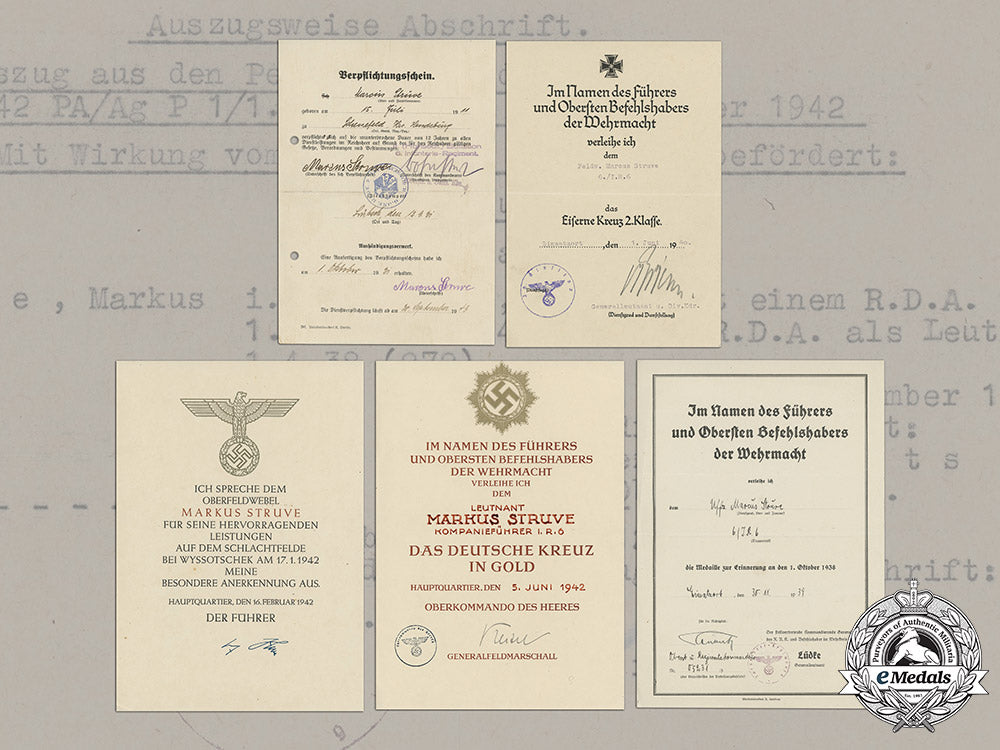
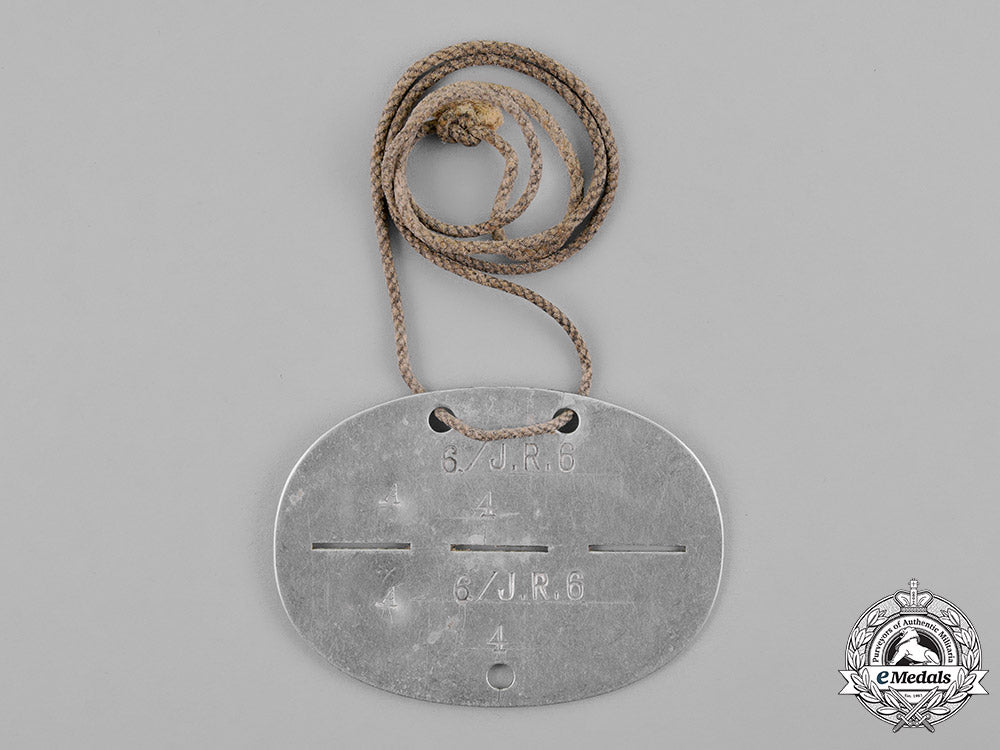
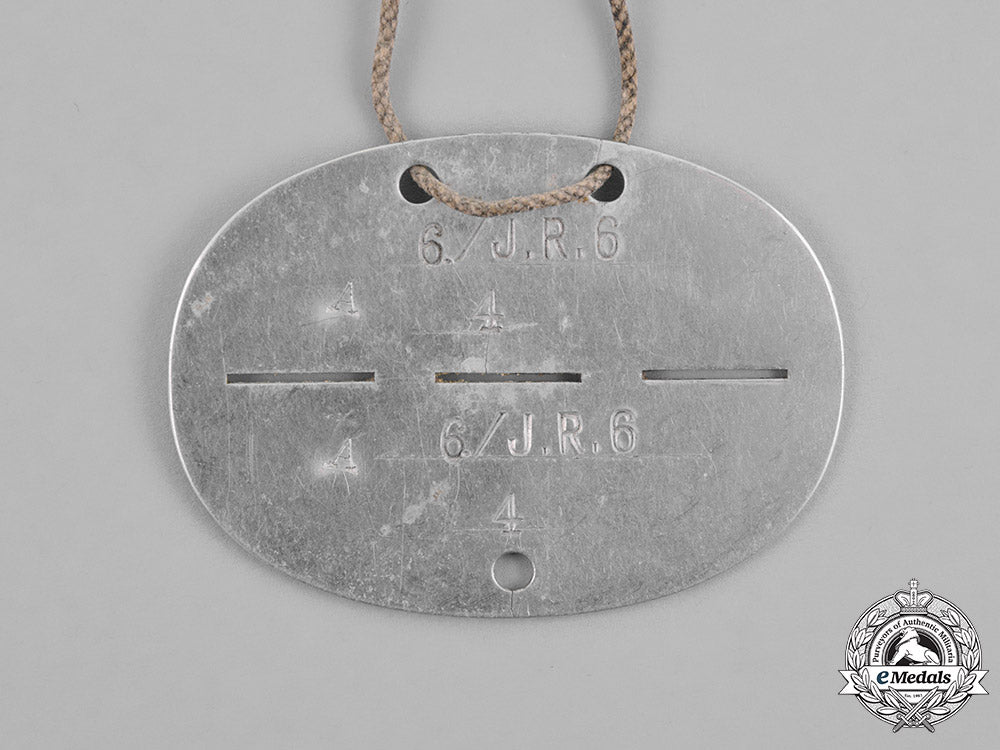
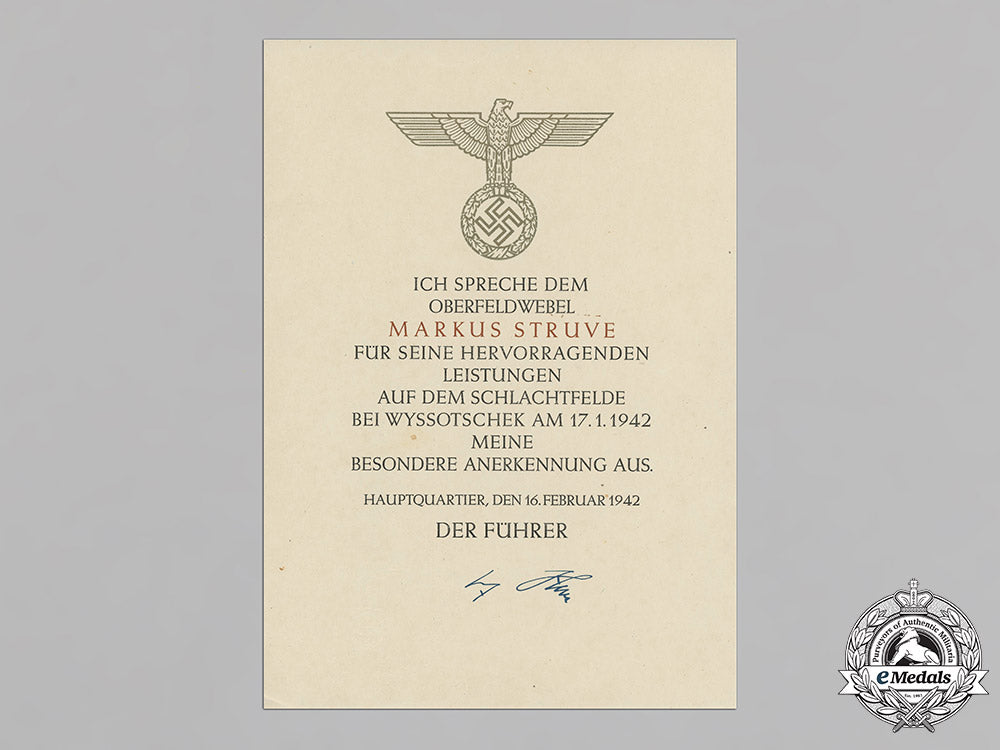
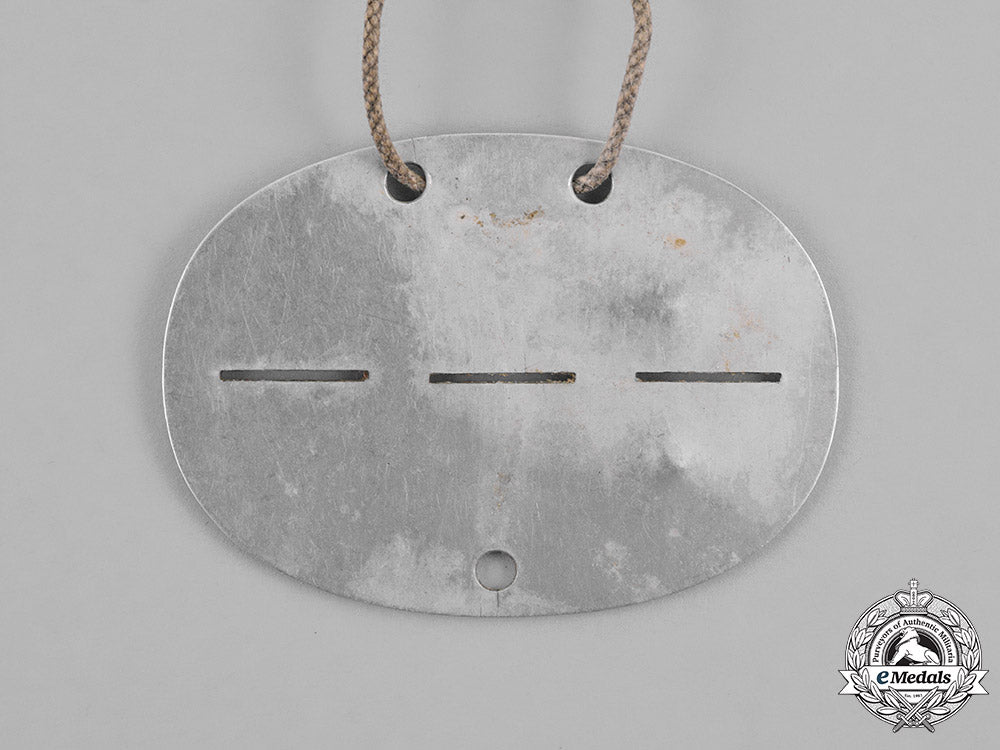
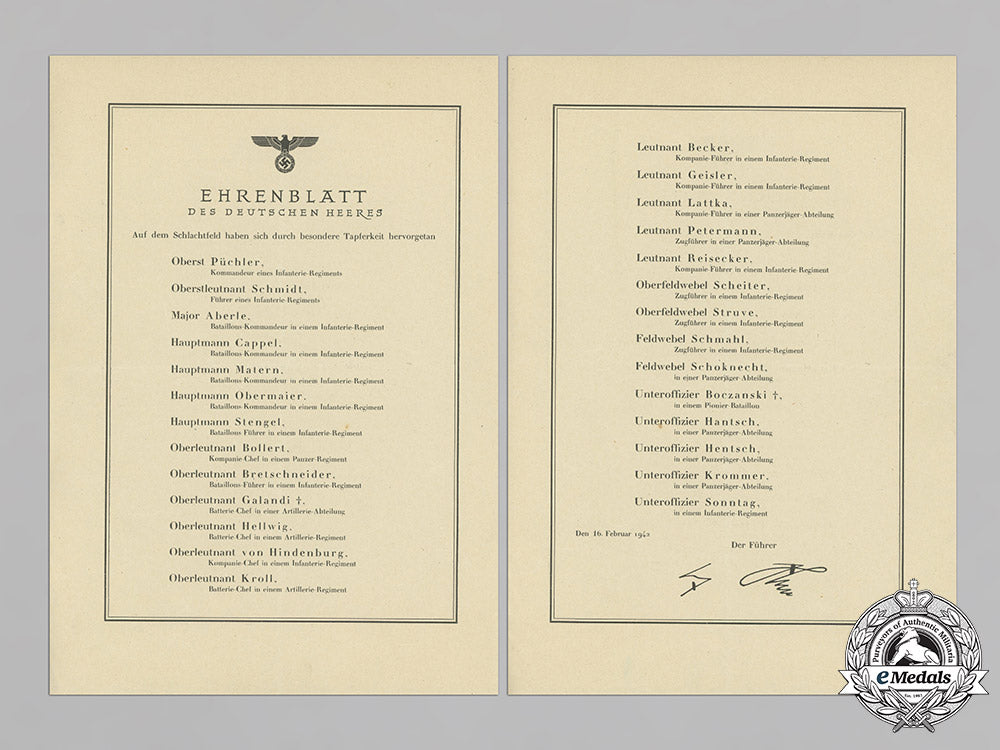
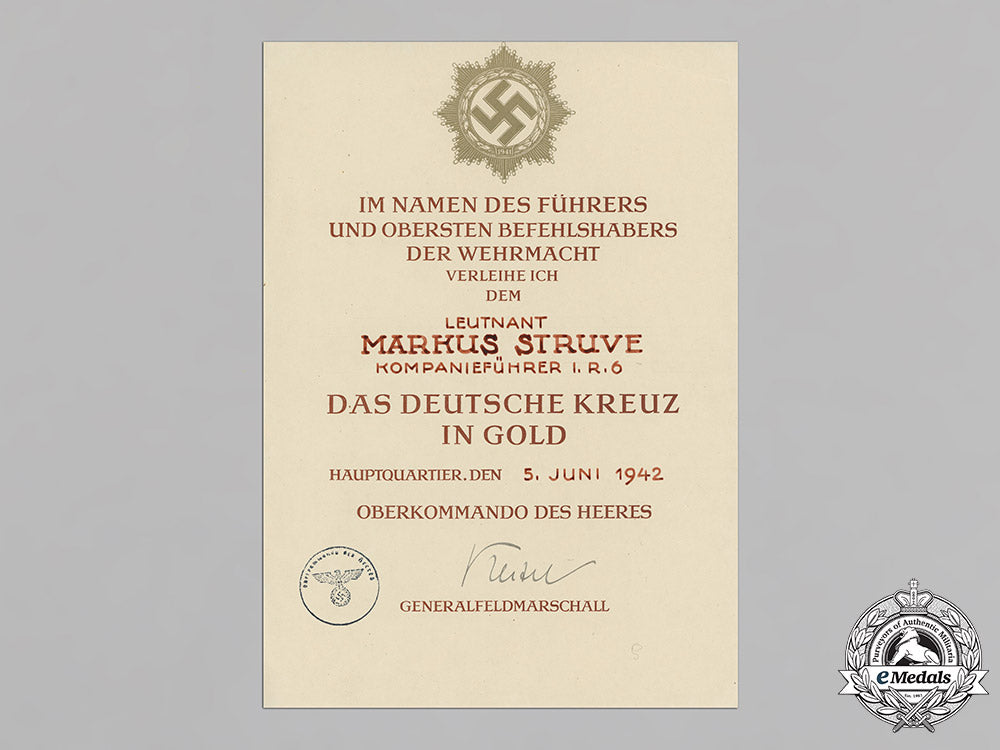
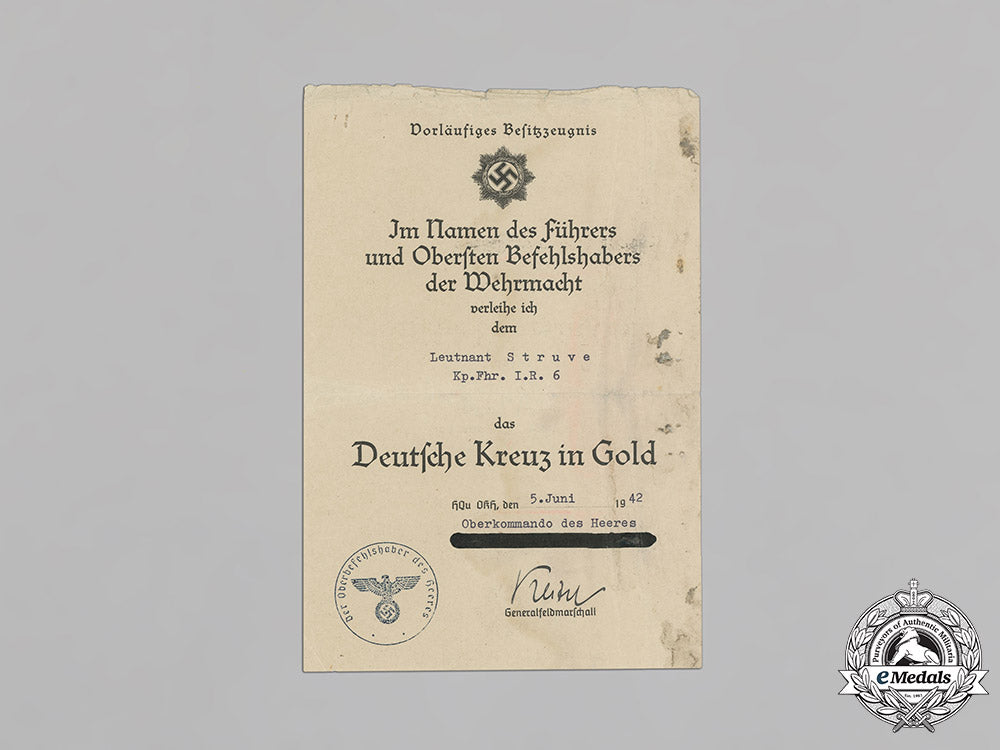
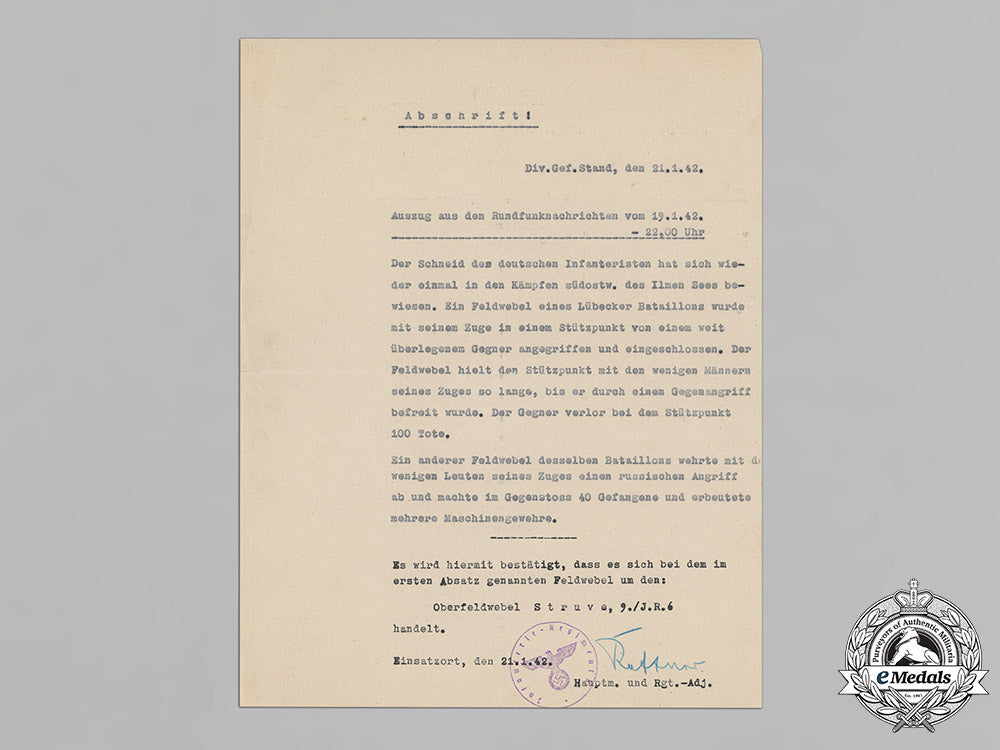
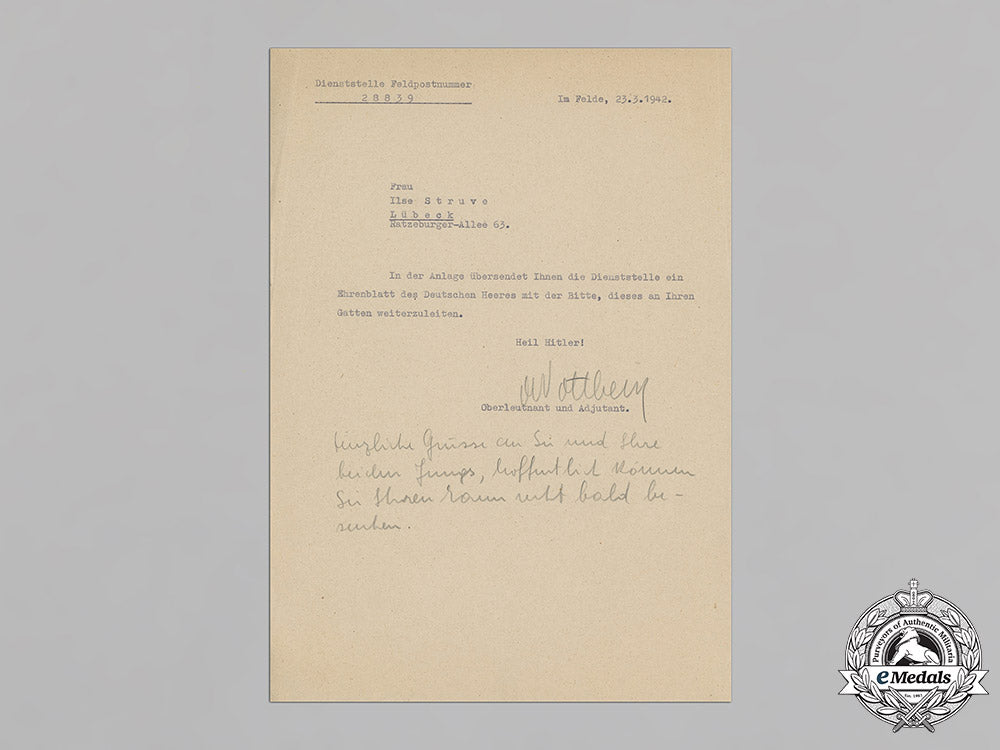
You May Also Like
Germany, Third Reich. A Mixed Lot of Uniform Insignia
G59693
Germany, SS. A Set of Waffen-SS Legal Service Obersturmführer Shoulder Boards
G59692
Germany, Wehrmacht. A Spanish Cross in Gold, Exhibition Example by Rudolf Souval, c. 1960
G59688
Germany, Third Reich. An Order of the German Eagle, II Class Breast Star, by Gebrüder Godet
G59687
Slovakia, First Republic. A Rare and Mint Freiwillige Schutzstaffel Cap Insignia, Third Pattern, German-Made by Augustin Hicke
EU23583
-
Germany, Third Reich. A Mixed Lot of Uniform Insignia
G59693
Add to CartRegular price $225 USDRegular price $0 USD Sale price $225 USDUnit price / per -
Germany, SS. A Set of Waffen-SS Legal Service Obersturmführer Shoulder Boards
G59692
Add to CartRegular price $485 USDRegular price $0 USD Sale price $485 USDUnit price / per -
Germany, Wehrmacht. A Spanish Cross in Gold, Exhibition Example by Rudolf Souval, c. 1960
G59688
Add to CartRegular price $650 USDRegular price $0 USD Sale price $650 USDUnit price / per -
Germany, Third Reich. An Order of the German Eagle, II Class Breast Star, by Gebrüder Godet
G59687
Add to CartRegular price $2,650 USDRegular price $0 USD Sale price $2,650 USDUnit price / per -
Slovakia, First Republic. A Rare and Mint Freiwillige Schutzstaffel Cap Insignia, Third Pattern, German-Made by Augustin Hicke
EU23583
Add to CartRegular price $2,450 USDRegular price $0 USD Sale price $2,450 USDUnit price / per
Do you have a similar item you are interested in selling?
Please complete the form and our client care representatives will contact you.
Sell Item